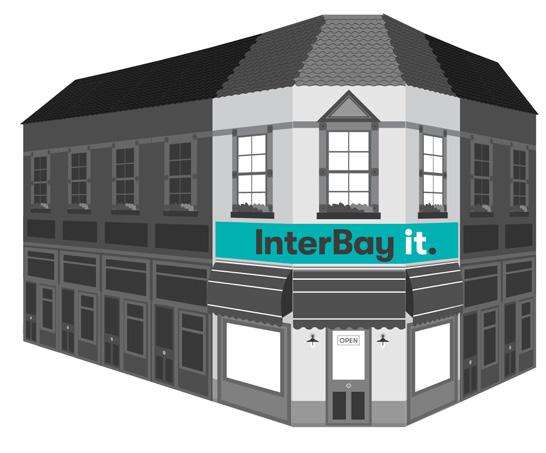LOOMING IN THE SHADOWS

+ The morphosis of the commercial property market p16


+ The morphosis of the commercial property market p16
Why make bridging difficult. Talk to Somo today.



To help you push ahead in 2024 we’ve made significant changes to our bridging finance offer including:
• Unregulated bridging loans available from 0.75% p.m.
• Minimum bridging loan size reduced to £100,000 for first and second charges
• Lending extended to cover all mainland Scotland with no postcode restrictions
Email: bridging@utbank.co.uk
Telephone: 020 3862 1002

There’s no denying that the commercial real estate market has suffered many hits over the past few years, as the macroeconomic challenges—including Brexit, Covid and volatile interest rates—have taken a toll on this sector. Nevertheless, here it is still standing, and with positivity slowly returning to the commercial real estate market, as reflected in RICS’s latest commercial property sentiment index.
With the commercial lending market being at a critical juncture, according to UK Finance, it is time to take an in-depth look at this sector’s good, bad and ugly to see what may be in store for this resilient market this year and beyond—which is exactly why we have dedicated this issue primarily to the commercial market, and its many sub-sectors.
As the latest research from Bayes Business School revealed new commercial lending has hit a 10-year low, and with 42% of £170bn of outstanding commercial loans due to be refinanced within the next 12 months, could this refinancing wave potentially cut the sector’s legs right as it’s trying to get back up? We set out to discover the answer to this burning question and uncover the dangers commercial property investors could soon face, with the help of several industry experts [p60].
On the back of the recently expanded permitted development rights, we also take an in-depth look at commercial-to-residential conversions with Octane Capital, to highlight the trends seen in this market and identify what makes a successful conversion project [p16]. We also uncover the hidden difficulties of investing in care homes—a sector that has seen a popularity boost over the past few years. Plus, Ortus Secured Finance’s CEO Jon Salisbury discusses his extensive career in the commercial finance sector, and shares his insights on how to remain successful in this market [p74].
As a special surprise for all our readers, we are bringing the magic of this year’s B&C Awards to print, with a unique and extraordinary spread to bring you back once again into the world of Alice in Wonderland—we hope this will add a sprinkle of magic into your world, and bring a smile to your face!
 Andreea Dulgheru Deputy editor
Andreea Dulgheru Deputy editor
Unlock your project’s potential with MSP Capital’s Ground-Up Development Loan. From standard deals to complicated lending, we’re here to assist you and your clients. Call us on 01202
Working alongside developer clients, we provide up to 65% LTV against the land value, plus 100% of your build costs. Unlocking up to 70% of the Gross Development Value.


“There’s
still a huge shortage of housing in the UK and, until that changes, things won’t improve as quickly as they could—after all, no one would build low-quality property if there was no demand for smaller, and therefore cheaper housing” p16
10 16 23 27 39 46 49 60 74 89 100 104
The commercial finance edition
Putting your money where your mouth is
The commercial market is getting a makeover
Beware the secret minefield
Hard work pays off / Ushering bridging into a new era
It’s getting tech-y in here
91% of brokers are still losing sleep
Commercial refinances: a ticking time bomb?
Jon Salisbury / Emma Ross
The blame game continues
Follow in our footsteps
Dawn Trustam
Fixed-rate commercial range
• loans between £250,000-£10m
• 75% maximum LTV
• 2% arrangement fee
• 1.5% procuration fee
• fixed- and variable-rate options available
• facilities available for commercial owner-occupied and investment properties
• available for sole traders, partnerships, LLPs and limited companies
• upto10.12%perannumROI
• minimum£1,000investment
• allowsinvestorstopart-ownrealestateassets
• capitallreturnsearnedfrombothrentalincomeandpotential growth
INTERBAYCommercialinvestorloans
• exclusivemortgageratesavailableviaSelectbrokers
• availableforcommercialandsemi-commerciallandlordsandinvestors
• ratesfrom6.19%forcommercialfirst-chargeowner-occupiedloans,and from6.39%forcommercialinvestors
• pricingfrom6.74%forsemi-commercialfirst-chargefacilities
• cashbackavailableonselectedsemi-commercialproducts
• £150,000minimumloansize
Commercial and semi-commercial loans
• £150,000 minimum loan size
• loans up to £35m
• fixed rates from 7.24% for commercial and from 6.34% for semi-commercial
Commercialmortgages
• loansbetween£150,000-£10m
• availableforUKlimitedcompanies,LLPs,partnershipsandsoletraders
• 80%maximumLTVforcommercialowner-occupiedmortgages
• 75%maximumLTVforcommercialinvestmentmortgages
• 2%arrangementfee
• loantermsbetween5-25years
• fixed-andvariable-rateoptionsavailable
MFSCommercialandsemi-commercialtermBTLmortgages
• loansbetween£150,000-£1.5mperunit
• loansupto£10mperultimatebeneficialowner
• 70%maximumLTV
• 130%ICRforallcustomergroups
• deferredinterestorrolled-monthsoptionsavailable
• availableforowner-occupiedpremises,retail,office,servicedapartments,PBSA,first-timecommercial landlordsandmore
HTBsemi-commercialmortgage
• two-andfive-yearfixed-rateoptions available
Commercialbridgingloans
• loansbetween£100,000-£2m
• maximum65%LTVofpurchaseprice/ marketvalue
• pricedfrom1.09%
• retainedinterest
• alltypesofcredithistoryconsidered
• ratesfrom6.19%fortwo-yearfixesand 6.59%forfive-yearfixes
• 75%maximumLTV
• 125%minimumICR
Catalyst Property Finance has recently secured a new £750m funding line to boost its shortterm bridging and refurbishment products. With new fuel in the tank, the lender is now gearing up to bring a suite of new initiative to market, as it aims to double its loan book
WORDS BY CHLOE WHELANIn April, Catalyst Property Finance made waves by announcing it has secured a new three-year, £750m funding line. The property lender now has three active funding lines to be deployed, including funds from an institutional-grade credit platform based in the US, alongside investments from several HNWI and its own cash reserves.
According to Catalyst’s CEO Chris Fairfax, the firm will deploy the £750m facility by improving its loan-making process, widening its credit policy and increasing capacity as it aims to double its loan book and take on additional risk. Put simply, the new funding line, together with its existing tranches, will allow Catalyst to say “yes” to more loans. “Every area of the Catalyst product range is being sharpened,” Chris explains.
Catalyst’s new US line highlights a broader trend of international interest being shown in the UK private credit market, Chris explains.
“The UK market is attracting investment from all areas of the world,” he remarks. “Over the past five years, large American credit investors have significantly increased their appetite for this risk. They are attracted due to both historical and forward-looking bridging loan asset-class performance and the risk-adjusted yield.”
Chris and his team considered many variables—including credit risk appetite, interest payment terms, advance rate, pricing, process tools and approach to valuations—when selecting a funding partner. However, his primary concern was whether the partner could support the competitiveness of the firm.
“Ultimately, what we are looking for is for funders to provide finance terms that allow Catalyst to be relevant in a saturated market,” Chris says. “There’s little point in having capital that’s cheap but narrow on credit, or flexible but exceptionally expensive. It’s about finding a good fit and there are a lot of great funders out there.”
While Catalyst’s new funding line originates from overseas, Chris doesn’t have plans to internationalise the lender’s product offerings. “As much as my team members drop subtle hints about Miami, for example, for now we remain focused on England and Wales,” he explains.
Catalyst has already begun deploying funds for new initiatives, including a ‘go Dutch’ proposition by which it offers to pay 50% of valuation fees upfront for bridging borrowers. The limited offer is available on all qualifying
“Each new initiative is a blank canvas; we won’t just follow the crowd, that’s just not in our DNA”
Catalyst bridging loans, up to a maximum contribution of £1,500 including VAT.
Valuation fee refund promotions are relatively common in the specialist property lender market. However, Catalyst’s offer is distinctive in that the contribution is paid upfront, as opposed to other initiatives that tend to provide the refund only after the successful completion of the loan.
Catalyst also plans to improve its low-LTV unregulated bridging products after feedback from brokers suggested the lender fell short in this area.
The new facility will also fuel a recruitment drive across most areas of the business to support anticipated growth following the recent appointments of a new senior internal BDM, a servicing administrator, a senior credit analyst, and a credit administrator.
Catalyst’s ambitious expansion plans come amid a difficult few years for commercial property, as the underlying businesses that support the market—including retail, hospitality and offices—struggled.
Retail and hospitality faced well-documented challenges as Covid-19-related lockdowns forced widespread closures, compounded by consumers cutting back on discretionary spending in response to subsequent cost of living pressures. In another post-pandemic trend, office vacancy rates remain stubbornly high with working from home continuing for many employees.
However, Chris notes signs of improvement in some areas of the property market. While all property capital values fell by 0.4% in the first quarter of this year, according to CBRE, this decline was driven solely by offices, the capital values of which fell by 1.7%. By contrast, capital values increased in both the retail and industrial subsectors.
Additionally, even within the offices subsector, Q1 was marked by a 49% increase in under offers for central London office space compared with the previous quarter, with
tenants and investors displaying a preference for new, high-quality developments.
“Areas such as warehouses and distribution sheds are appealing,” Chris notes regarding market performance in the past 12 months. “The primary office sector is starting to see signs of improvement, as we have seen a slight shift in the WFH culture, with more office work, albeit flexibly. The hospitality and leisure sectors continue to experience challenges due to inflation and the increasing cost of living, which is likely to continue,” Chris adds. “Broadly, luxury assets buck the trend as consumers remain able to support these types of businesses.”
While the macro environment has proved challenging, Chris says his team continues to consider the same key factors in every area of lending. “We need to have confidence in the security value, sufficient time for the loan, a reasonable exit strategy and to consider the enhanced volatility of the underlying asset.”
Looking ahead, Chris hopes the latest cash injection will help it deploy more loans, widen its credit policy and support the infrastructure that Catalyst needs to achieve its goal of doubling its loan book in a disciplined way.
“We have worked with our funding partners to establish areas of risk we believe are sensible for the medium term and made adjustments to present terms which have a greater chance of being recommended by our broker partners.”
These ambitions will come off the back of Catalyst’s broader goal of providing distinctive value for borrowers and mortgage intermediaries, Chris states. “As a team, we talk about our targets in terms of providing meaningful solutions to borrowers, enriching relationships with our broker partners and managing our loan portfolio,” he offers. “In 2024 and beyond, we will continue to build on Catalyst’s foundation of disrupting the market. Each new initiative is a blank canvas; we won’t just follow the crowd, that’s just not in our DNA.”
It’s no secret that bridging finance has become considerably more mainstream in recent years. While traditionally seen as a very specialist product, our customers are now utilising the fast, flexible finance bridging provides for a variety of uses
Flipping a property for profit
When flipping a property, often buyers don’t need long-term financial solutions like a mortgage. Many of our customers are using bridging loans to fund the purchase and renovations, complete the work within a specified timeframe (typically months) and repay the loan once the upgraded property sells.
a broken property chain
A property chain is often reliant on needing the funds from the sale of an existing property to purchase the next home. A break in that chain, where a buyer pulls out or delays a deal, can be frustrating for the seller as they won’t be able to move until their sale is complete.
Lots of customers use bridging loans to access the necessary funds to purchase their new home, repairing the chain break. It also gives them time to sell their existing property for the right price, without feeling pressured to sell quickly below market value.
EY’s 2024 Bridging Market Survey found that refurbishment is still the most popular use for bridging finance, and this certainly tallies in with what we have seen. That said, the application of this finance is far more versatile, and it’s worth keeping up-to-date on what it can offer you or your customers. Here are some of the most common applications we are seeing from our customers:
Waiting on guaranteed funds to come in
Similar to sellers experiencing a chain break, there are individuals who are looking to buy, but are in income limbo. Their money might not be tied up in property, but could be in the form of an inheritance, divorce settlement, income payment or other investment asset that they are expecting to come to fruition.
These processes can take several months to complete, but circumstances may mean that the individual needs to move to a new property quickly. A bridging loan allows someone to buy the property now and repay the loan once they receive the expected funds or secure longer-term finance.
Improving the EPC rating and energy efficiency of a property
A bridging loan can allow a property owner to fund improvements, such as adding wall and ceiling insulation or installing heat pumps or solar panels, that would raise its EPC rating and reduce energy costs. In addition to highlighting energy efficiency, a high EPC rating could also add considerable value to a property and be a positive contributing factor for potential buyers.

New owners transform run-down dogs home after securing £400,000 loan
A Gloucestershire mum transformed a rundown kennel and cattery, and is now ‘living the dream’ as she prepares to expand thanks to finance from Together.
We provided an initial short-term bridging loan 12 months ago for the purchase of the kennels, called Elmview. She now plans to use the funding to continue to renovate the kennels, and wants to eventually expand dog rescue—this will include the addition of six new kennels for Elmview, which will help Aura Dogs through the season.
Together was to give her the initial short-term loan, and when she proved that the kennels were a great success, we were more than happy to extend her term to allow her business to continue to thrive.
A bridging loan can be used if an individual or business has existing debt on a property and needs to quickly replace it. For example, the existing finance could be about to run out before repayment is possible, resulting in costly penalties.
In a business scenario, there may be times when owners need to raise capital quickly. A bridging loan can help to quickly pay off an unexpected tax bill, buy raw materials to fulfil a large order, or take advantage of a business opportunity.
Renovating a residence for rental, or a business property before trading
Using a bridging loan to purchase and renovate a rental property serves two main purposes. Firstly, landlords can quickly purchase and renovate their property so it’s in a habitable shape for tenants to move, thus creating income. It also allows landlords to address any problems with the building that a lender might have, like structural issues, making it easier to get a long-term BTL mortgage at a lower rate. Similarly, a bridging loan can be used by businesses looking to revamp their property before trading. When the business doesn’t have funds upfront to pay for the necessary improvements, they can use a bridging loan to complete them. Once they start trading, the money generated can be used to repay the loan and any accrued interest.

Case study 2
‘I’m in!’ Dragon’s Den winner reveals £10m expansion plans for his glamping business
A dad of two who won investment from TV’s Dragon’s Den used a bridging loan of £1.6m to expand his glamping business.
The entrepreneur has now revealed he’s bought a second site, La Mancha Hall, a mid-18th century 5,200 sq ft Grade II-listed mansion with outbuildings, set in ten acres of land including formal gardens and protected woodland.
He was able to buy the new site thanks to investment from Together and said he had major ambitions to create a business worth more than £10m over the next two years.
quickly on an opportunity to purchase
With a bridging loan, business can quickly secure the property or land they need to meet their growth ambitions, and then pay back the loan and accrued interest once assets are sold or expected profits are generated. Additionally, having the ability to act as a cash buyer is advantageous when a vendor needs a quick sale and is prepared to sell the property or land at a discount.
With a bridging loan, the buyer can secure the property before the 28-day completion deadline, ensuring they don’t miss out on their opportunity. Once purchased, they can renovate the property up to the standard required to either secure long-term finance or to sell the property for profit.

charge, cross-charge and second charge bridges with multiple exits available | Any property type considered across England, Scotland & Wales.


only

The chronic undersupply of residential homes, the large number of vacant commercial properties on the back of the pandemic and relaxed permitted development rights (PDRs) have turned commercial-to-residential conversions into an attractive opportunity for property investors. Octane Capital’s managing director for sales, Richard Deacon, director of structured finance, Alex Tyrwhitt, and director of credit Matt Smith, discuss this trend and its evolution in depth
 Words by ANDREEA DULGHERU
Words by ANDREEA DULGHERU

“Commercial landlords are recognising that the occupiers and operators no longer need that large ground-floor unit or the ancillary space in the upper floors, so they’re sweating these assets the best they can”
At the beginning of the year, Octane surprised us with a new look following its rebrand. While the firm’s logo and proposition have seen a refresh, the lender’s ethos remains the same: to provide specialist finance and help clients get their projects from plan to profit.
According to the team, one of Octane’s most popular products is its refurbishment option, which offers loans up to £15m at maximum 70% LTV—potentially higher for select cases—and covers 100% of refurbishment costs. Matt tells me that over the past 18 months, the lender has seen a significant increase in commercial-to-residential conversions, particularly of offices into new homes.
While permitted development conversions of offices into residential homes have been trending for approximately 10 years, Alex explains that the initial market surge eased a few years ago as investors got to grips with the new rules and regulations being implemented. “A lot of the stock that was easily convertible was done quite early on. There’s also been a lot of legislative changes over the last few years in terms of minimum space sizes and the quality of what’s being built. That paused things for a period, while people came to terms with what the new landscape looked like, and to find those opportunities that hadn’t been developed yet.”
Aside from residential-to-HMO conversions—which, according to Richard, are the most popular types of projects the lender is funding—Octane has seen significant demand for one specific type of conversion scheme: semi-commercial-to-residential change of use projects in which owners look to halve the commercial space on the ground floor and transform the rest into ground-floor flats, in addition to residential units above.
“Structurally speaking, the retail market has changed. A lot of the traditional retail units on the high street are now oversized, because most retailers don’t carry a lot of stock anymore. Commercial landlords are recognising that the occupiers and operators no longer need that large ground-floor unit or the ancillary space in the upper floors, so they’re sweating these assets the best they can,” explains Alex.
There is a significant amount of vacant commercial space across the UK—including roughly 130 million sq ft of office space, according to Cluttons. Nevertheless, Richard, Matt and Alex explain that not all such spaces are fit to be turned into homes.
“When commercial-to-residential conversions first started, you had fairly ugly buildings being converted pretty poorly at low cost in town, and delivering small units. Often times, developers found they couldn’t let the homes once completed, so they ended up in some sort of agreement with a local authority to provide temporary or council housing. There is a large amount of this type of existing stock currently in the market,” Alex elaborates.
Matt cites conversions of out-of-town business parks as representative examples of such unsuitable schemes. “Aesthetically from outside, they still look like offices,” he explains. “Yes, you get 200 car parking spaces, but people don't want to be out of town. They are looking for homes near train stations, town centres, hospitals, universities etc. Plus, people are living low-cost; they haven’t got two cars to park, they’ve got two legs to walk to the station.”
This is why the trio believes finding the right location, and understanding what type of property is in demand for a particular area, is essential preparation.
The structure of the commercial asset being converted is also a key factor to be considered. For properties that do not fall under the recently relaxed PDRs—which now cover particular commercial units, including offices and agricultural buildings—the person undertaking the conversion must obtain the necessary planning permission; not an easy task considering the severe delays that planning departments are experiencing. Moreover, commercial landlords and investors undertaking a conversion scheme may find deleterious materials in the fabric of the building, such as asbestos or high alumina cement
(HAC), the latter of which can compromise structural integrity. That would lead to additional costs for their removal, or make the project unviable.
Office buildings may also need external alterations to make them more aesthetically pleasing and usable for the residential client, as commercial properties are often designed with different priorities in mind. “Purposebuilt office buildings are not necessarily the most attractive,” says Alex. "You’re always looking at the physical aspects of a building. Also, internally, does it subdivide well into multiple units? Quite often, a lot of office buildings can have very wide floor plates—so how does that look when you translate it into X number of flats that you try and fit into the same space?”
There are a multitude of factors that Octane will look at when considering which deals to fund, including location of the asset and local demand for the type of property being converted. The lender is equally open to providing specialist finance for projects that already have planning approval and for those without. For the latter, it can offer a planning bridging loan and then transfer the client onto a refurbishment facility to carry out the conversion.
However, the team tells me that two factors are particularly important for the firm: the experience of the overall team of contractors undertaking the conversion project and the marketability of the finished product. “The sizes of the flats, for example, will have a bearing on how we value the property and structure a loan around it,” Alex elaborates. “If a flat is under 30 m2, it would fall below minimum space standards for individual mortgages, so that would have an impact on how marketable those units are. It just goes back to funding the schemes in the right locations, which have that underlying demand and lend themselves to being occupied by private tenants or bought by owner-occupiers.”
“People don’t want to be out of town. They are looking for homes near train stations, town centres, hospitals, universities etc. Plus, people are living low-cost; they haven’t got two cars to park, they’ve got two legs to walk to the station”

“For the people that we lend to, the quality of the property matters, not just because they’ll be looking to fill their buildings with tenants or sell their units, but also because they want the property’s economic life to be extended. You don’t want to cut
an
While some have welcomed the PDR changes, arguing they breathe new life into unused commercial properties, some experts have raised concerns about these types of conversions leading to the delivery of poor-quality housing. Among the sceptics are University College London professor of spatial planning and governance Ben Clifford. However, Alex believes that such conversions have seen an increase in quality over the years, partly driven by regulatory changes, such as new minimum space requirements.
“Equally, for the people that we lend to, the quality of the property matters, not just because they’ll be looking to fill their buildings with tenants or sell their units, but also because they want the property’s economic life to be extended. You don't want to cut costs converting something from an office to residential, only to have to replace things in the building within five years because you installed poor-quality boilers or some cheap laminate flooring that will start peeling off in the first three years. While you might be saving £5-10 per sq ft, the reality is you've just got to replace it every three to five years, so it doesn't make financial sense to do that,” Alex explains. “If the finishes are beautiful, hotel-like, you can charge a higher rent and, generally speaking, you get a higher-quality tenant,” adds Richard.
office
to
costs converting something from
only
residential,
to have to replace things in the building within five years because you installed poor-quality boilers or some cheap laminate flooring that will start peeling off in the first three years”
The improved quality of commercial-to-residential conversions is also a result of investors’ continued interest in boosting their properties’ energy efficiency, despite the previously proposed MEES rules for domestic properties having been scrapped. “We are seeing a lot more conditions attached to planning consents by local authorities that require certain levels of sustainability credentials to be met, or environmentally friendly products to be used,” says Alex. “Pretty much every consent I’ve looked at recently has had a requirement for EV charging points in car
parks, and/or solar panels on the roof. There's so much new technology coming out in terms of sustainability and it's improving all the time. Our clients use it and we love to see that. It’s a huge part of the market for sure, and it's something that we look at when assessing conversion projects.”
Nevertheless, Matt argues there is still room to further improve the quality of commercial-to-residential conversions. He believes this will be driven by increased demand for high-quality residential properties from tenants and buyers, as well as by the tightening of the building control regulations. “The problem is there’s still a huge shortage of housing in the UK and until that changes, things won’t improve as quickly as they could—after all, no one would build low-quality property if there was no demand for smaller, and therefore cheaper housing,” he adds.
Looking ahead, the trio expects to see continued interest in commercial-to-residential conversions over the next 12 months and beyond. “We’ll continue to see more of these projects as town centres are going to be reshaped—that’s not something that’ll happen overnight, but rather something that will occur over the next 15-20 years. It’s an interesting and very diverse market, and it's one that you really need to understand to lend into,” Alex concludes.





Max Lewis, chief investment officer and cofounder of specialist bridging lender Hilco Real Estate Finance (HREF), discusses some of the less known difficulties facing the care home investment sector, and looks at this market’s future prospects
“While care home businesses can be very profitable and operate in a market benefiting from structural growth, the seismic hit the sector took during Covid will take some time to recover from”
The care home sector continues to attract the attention of a broad pool of investors, given the combination of favourable demographic trends and the potential for higher profits than more mainstream real estate assets. However, with the sector having faced multiple challenges in recent years, operators and brokers are now finding that they are also facing some obstacles in the form of limited access to finance.
Even before care home operators entered the stormy waters caused by Brexit and Covid, rising costs, particularly in terms of salary inflation (and outright shortages of staff) was a persistent problem. This has been exacerbated by the April 2024 landmark government policy which saw an increase to the national minimum and living wages. With the adult minimum wage having risen by 70% in real terms since its introduction 25 years ago, according to the Low Pay Commission, this is usually one of the biggest expenses in a high-labour environment like a care home, with operators telling us that wages often account for at least half of gross revenues. Regardless of the challenges, many care home operators are looking to a brighter future given the UK’s ageing population and the need for greater numbers of highquality care facilities. Although keen to invest in expansions and improvements to deliver the comfortable, high-spec facilities residents and their families are demanding, care home owners are finding that securing the funding they need to realise these plans is far from easy.
While care home businesses can be very profitable and operate in a market benefiting from structural growth, the seismic hit the sector took during Covid will take some time to recover from. We’ve witnessed the combination of low admission rates and high mortality result in severe occupancy drops for many operators, and ramping back up to full occupancy will not happen overnight. Faced with cost pressures and depressed occupancy, the recent rise in interest rates has been a further significant burden for leveraged owners.
This uncertain environment has led to the retreat of many funders, in particular mainstream banks, which appear to be nervous following adverse news headlines. Having become more complicated to underwrite, care home businesses have simply become regarded as ‘non-core’ to many traditional lenders. Banks appear to have pulled away from all but straightforward residential mortgages and, unfortunately, it seems that the care sector is another casualty of their shrinking lending activities. As a result, care home operators have a much narrower pool of active lenders from which to choose, and many are discovering that the banks with whom they have had long-term relationships are now looking to exit this sector.
In this difficult landscape, a care home group which has banked with the same lender for decades might now find themselves unable to refinance with the firm due to its exit from the care sector. In the worst instances, borrowers are even finding that they are being ‘un-banked’, with the original lender having sold their loans to a more aggressive creditor. One operator we came across found that, despite having had a long-term relationship with their bank, their debt had now been sold to a hedge fund with no interest in or understanding of the sector. The new funder simply wanted their money and threatened to appoint receivers immediately if the loan was not repaid—these funders tend to be inclined to enforce more quickly than a mainstream lender.
Given the sector’s challenges, borrowers seeking either to refinance or to fund new acquisitions face a challenge complying with the covenants of a normal commercial lender. A lender will typically require evidence that their loan can be serviced from the borrower’s operating profits, with a margin of safety. For example, a debt service cover ratio of 2x would mean that a borrower needs to evidence that they have regular monthly free cash flow equal to 200% of the monthly loan cost. The typical evidence required is two years of prior accounts. The combination of volatile occupancy and rising operating costs, combined with higher interest rates, makes it hard for many operators to comply with such covenants.
Faced with higher operating costs, a logical response for care home owners is to invest in upgrading their properties to achieve higher revenues. However, funding for such capital expenditure can be difficult to obtain, especially if it will mean a short-term period of reduced occupancy. We’re also hearing that while a new home used to take around 18 months to reach full occupancy, this is now often taking twice that time. From a funding perspective, the difficulty is that while operators may be able to secure development finance and later loans once the home has become a stabilised asset, there is a gap in the middle where the business is unlikely to meet the criteria of a mainstream lender.
While consolidation remains a key growth strategy for many in the sector, as evidenced in a 2023 report by BDO, the care home businesses which represent the most attractive acquisitions for operators are often those with some problems, such as low occupancy, low fees, high overheads, poor management etc. While a new operator would obviously seek to fix these issues, the added risk is off-putting to many potential lenders, and it could take some years for the care home to reach full occupancy and be in a position to service the loans. This is where a specialist bridging lender would really add value, not only recognising the business’ longer-term potential, but, crucially, being able to roll-up the interest with the repayment of the loan.
In particular, ICR calculations are proving to be an issue. These are lender covenants requiring borrowers to have profits (normally measured as earnings before interest and taxes, or EBIT) that exceed the monthly interest cost by a given amount. For example, a loan might require a borrower to maintain EBIT of at least twice the interest amount. A borrower who is regularly servicing their loan may, therefore, still fall into default.
It’s important to look at how the figure is calculated, and also whether a single bad month or quarter would put the borrower in breach. ICRs are measured in different ways, sometimes by looking at past trading or forward projections; however, as care homes have seasonal fluctuations (for example, mortality tends to increase in the winter, resulting in falling occupancy), it is vital that borrowers understand the criteria. While these types of covenants are commonly waived, they can be enforced if a lender elects to do so in order to trigger a default.
As an experienced team with deep understanding of the care sector, there are four key criteria we consider when assessing lending to a care home business—however, it’s not necessary for a home to meet all four in order to secure finance. We assess every single potential deal on its own individual merits and do not rigidly exclude any scenario. This flexible approach is the only one in our view that can effectively meet client borrower demands and capture all the nuances present in the highly specialised care sector.
In our view, the most attractive deals require: a modern home offering a good quality of accommodation; a sufficiently affluent location with a substantial percentage of private paying residents; an undersupply of care home beds in the area with a limited pipeline of new developments; and an experienced operator with a good track record.
Nevertheless, it’s possible to borrow without meeting all four criteria—for example, as a new operator or against a home in a less affluent location.
Looking to the future, we are confident that the care home sector offers huge potential for the right operators and investors. Specialist bridging lenders can provide care home businesses a number of vital benefits including swift decision-making and taking the time to understand the specific circumstances of the lend; no need to service the debt monthly; and the ability to look beyond recent weak lending history. While bridging lending is not a long-term solution, it can be a useful tool when acquiring, selling or repositioning an asset such as a care home.
The long-term trend of an older population with people living longer and having more complex care needs, won’t change any time soon. The key question for this year will be around the ability for operators to pass on fee increases in order to offset rising costs. This will undoubtedly result in some challenging conversations, both with private residents and local authorities.


As Roma Finance celebrates its 15 th anniversary, its founder and managing director Scott Marshall takes us on a trip down memory lane that starts at the lender’s humble origins and continues all the way to the thriving, multi-million-pound specialist lender
Words by ANDREEA DULGHERUoma Finance has solidified its spot as a significant player in the specialist finance market—particularly as the business is celebrating its 15th anniversary this year, showcasing its resilience and longevity. However, for Scott, Roma is more than just a lender: it is a true testament to his perseverance and ambition.
The Manchester-based lender was born at the end of 2008, one of the toughest times for a finance company as the UK faced the storm caused by the global financial crisis. This timing was made even worse by the fact that at the time, Scott lost his job as credit risk director at Lancashire Mortgage Corporation (now part of Together), where he had worked for almost six years.
Being made redundant is a disastrous and stressful situation that nobody wants to find themselves in, particularly when they have a family to care for and bills to pay, like Scott. However, he saw it as an opportunity to pursue a different route, one that would provide the
“I always wanted to have my own lending business, but the actual reason why I set up Roma after being made redundant was just because I needed a contingency plan”
thrill and challenge that he was looking for.
“My wife was devastated, and was worried about how we were going to make a living and take care of our three young girls, but I remember telling her that I felt it was the best thing that had ever happened to us,” Scott recalls. “Sometimes when you have a job [that you’ve been in for a while], things can become stale and you need a push to press the restart button. In the nine months before I was made redundant, I felt stagnant and that I needed a new challenge. So when I lost my job, to me this was the start of a new beginning.”
With only a strong intuition that this was the right path for him, and with tremendous pluck, Scott set up Roma Finance as a secret side hustle to his full-time job handling global procurement at an IT firm. He gave his company a portmanteau name created from those of his grandparents, Rose and Max. “I always wanted to have my own lending business, but the actual reason why I set up
Roma after being made redundant was just because I needed a contingency plan. My wife said I couldn’t be reliant on the IT job for our future, and advised me to have something else in the background if I found myself in the same situation again,” reminisces Scott.
A matter of perseverance
At the beginning, Roma Finance handled underwriting for a number of clients, primarily Jonathan Samuels’ business Drawbridge Finance—which later became Dragonfly Property Finance—all while doing his regular day shifts at the IT company. However, this was short-lived, as after about a year, the underwriting work started to dry up.
Knowing this was not a sustainable way to keep going, Scott pondered the next steps and decided that, with his lending experience, his knowledge of the market and his extensive contacts book, he wanted to give lending
a go himself. And so, during a two-week family holiday that should have been spent in the sun, Scott researched and successfully completed all the steps needed to turn Roma Finance into a specialist lender.
While on paper the firm was open for business, Roma Finance lacked two essential things to make it as a specialist finance provider: customers and cash.
To solve the first issue, Scott would spend each lunch break allocated as part of his IT job—which he continued to do until 2014—in his car, calling every broker he knew to arrange finance deals. “Most people were taking their lunch at the time, so I’d then get a load of phone calls in the afternoon that I couldn’t take because I was at my desk doing the IT job. This meant I had to call people back in the evenings, but they often wouldn’t be available then. It was very difficult.”
The first deal came three months later, in November 2020—a £75,000 second-charge mortgage for a London diamond dealer who was looking to use the funds for business purposes. “The only option in the market at the time for a second-charge mortgage was Blemain Finance (now Together); the cheapest rate they did was 11.9%, and the shortest term was seven years, but the customer wanted a five-year loan,” recalls Scott.
Determined to beat Blemain’s offer and secure this deal, he promised the borrower the £75,000 over a five-year term priced at 11%, which the diamond dealer accepted. With the help of a lawyer friend—Richard Buchalter, owner of Richards Solicitors—who
helped him sort out the legal documents for the unregulated loan and who agreed to take his fee from the loan completion fund, Scott completed his first deal on 15th December 2010. The only problem? Roma Finance did not have any funds to lend.
With five weeks remaining to raise the necessary money for the loan, Scott chose to take equity out of his own home, which covered part of the total facility. The rest of the funds were provided, surprisingly, by his boss from the IT company.
This all started with a fateful carpool ride with his manager Alan, during which Scott opened up about his Roma Finance business, and was advised to speak to the company’s top boss, who turned out to be the manager’s brother. “I went and sat in front of the boss and told him everything. Long story short, he said he’d put the rest in for the £75,000 secured loan. From that one conversation, the stars were aligned and he became my business partner,” says Scott.
With his boss becoming its first investor, Roma Finance went on to complete several more different loans over the course of five years. During that time, Scott split most of his days between his IT day job and working at Roma Finance. To help with the workload, Scott hired the lender’s first member of staff, Daniel Hill, in January 2014. “We spent the first three months of 2014 mapping out the market, looking at competitors, where opportunities were in the market at the time, and coming up with a business plan to decide which niche within the property
“I didn’t start taking a wage until October 2014, so the irony is that I was the second employee in my own business”
market we were going to attack,” says Scott. “Funnily enough, Daniel was officially the first Roma Finance employee—I didn’t start taking a wage until October 2014, so the irony is that I was the second employee in my own business.”
That was also the year when Scott realised he was spreading himself too thinly, and when he was forced by circumstances to choose between his IT job and his work at Roma Finance. “I was working 14-16 hours a day, six-and-a-half days a week, without drawing a wage at all. By the end of August, having two jobs became too much for me. I knew Roma Finance was my future, so I handed in my notice from the IT company,” Scott elaborates. “The odds of making it work were really stacked against us in the early days. I wasn’t a wealthy guy, I had to feed my family, and I had to run the business on a shoestring budget. It was proper hard work and graft to get it working, and Roma’s success is testament to the belief that I had in myself, the trust that my business partner had in me, and the hard work that Daniel put into the business in the early days.”
Taking things to the next level
Two years later, in 2016, Roma Finance evolved further after securing its first official funding line with RBS—a £10m facility with an accordion to £25m—which boosted the firm’s capability to provide residential and commercial bridging finance. This was put into
place shortly after Scott’s meeting with the bank’s portfolio director at the time, Warren Mutch, who was impressed by Roma’s thick lending manual put together with the help of late industry heavyweight Benson Hersch.
“After we had dinner that Thursday evening, I showed Warren our branded lending manual in a Tesco’s car park, of all places, and he loved it. He told me he’d speak to RBS’ credit team and let me know within a week if this was something they could take forward. Instead, I got a call the next day, saying the bank had an appetite to work with us,” recounts Scott.
The two businesses started the due diligence for confirming the funding line in March 2016, which was credit approved in May. However, as the funding deal was progressing through legals, one big thing happened: the Brexit referendum.
“I remember waking up the following Friday morning, asking myself: what do I do now? In the end, I decided to pare back all the LTVs by 5% across the board at Roma Finance, because we didn’t know what the future would look like,” Scott tells me.
The funding line was completed on 11th July, two weeks after the monumental political vote to pull the UK from the European Union. With that line in place, Roma Finance was propelled into the specialist finance sector.
“I’m looking to grow the firm and create something of value for its shareholders, staff, our funding partners and our customers. We have not even scratched the surface of what we can do”
A year later, the lender secured its second funding line, this time with Cambridge Building Society, which was initially allocated for bridging business. The relationship with Cambridge Building Society remains strong to this day, with a new £120m lending facility agreed in October last year.
Fast-forward to the present day, and Roma Finance is a completely different business compared with the one-man operation it used to be back in 2009. The company now boasts 60 team members and 10 funding lines, and provides finance for an average of 100 deals per month.
Roma Finance’s proposition has evolved with each new funding line added to its roster. Now, the lender offers residential bridging, auction and refurbishment finance, development exit loans and development finance up to £3m.
Over the years, the firm has strongly embraced and embedded fintech into its processes to further improve its lending capabilities. The technology solutions the lender has implemented include open banking technology, fintech to extract data from a
borrower’s passport chip, and its bespoke processing channel, RomaFLOW. This was created to speed up the application-to-completion process and make submissions easier for brokers. “We’ve always tried to be a market leader and pioneer in our sector,” says Scott.
Looking ahead, Roma Finance is working on securing its 11th funding line. “The next funding will take us to another level in terms of loan book size, customers and technology,” Scott states.
Above all, he is determined to continue taking the business to new heights. “I'm looking to grow the firm and create something of value for its shareholders, colleagues, our funding partners and our customers. We have not even scratched the surface of what we can do.”
Property valuations are our business. We ensure valuations are more accurate and your lending decisions are clearer.
This is why we created Knowledge Hub, a library of short one-to-two-minute videos, bringing together our know-how and experience. We answer many of the commonly asked questions about valuations, property and the market.
Visit the Knowledge Hub at vas-group.co.uk, or to propose a topic for us to cover.

See how VAS can add value to your valuations. Call our team on 01642 262217 or email info@vas-group.co.uk
 Pictured (L-R): Matt Mawdesley and Richard Lawton
Pictured (L-R): Matt Mawdesley and Richard Lawton

A new specialist lender has entered the market, one that promises to redefine bridging finance through the power of fintech: Morpheus Lending. The mastermind behind the new firm, Matt Mawdesley, and the finance provider’s operations director Richard Lawton give me an exclusive overview of Morpheus’ digital-only lending process and its plans to disrupt and innovate the market

“I think there’s a better way to do bridging: the process can be automated, and the customer and broker journey can be improved via digital tools to ultimately do things quicker and more efficiently”
Over the years, bridging finance has embraced technology in some shape or form— whether that’s AVMs and desktop valuations, broker portals or simple e-signatures—to enhance the lending process. However, one firm is ready to take this to the next level.
A brand-new finance provider that made its entrance into the market in mid-May— celebrating the launch with a fabulous party in Manchester. Morpheus Lending was created with one goal in mind: to revolutionise bridging lending by creating a digital-only bridging finance provider.
The idea all started back in September last year, when Matt Mawdesley was approached by chartered accountant Lee Jones and Sandeep Malhotra to launch a new bridging lending firm.
For Matt, who had just left his role as head of strategy and innovation at Together, this was the opportunity to do things better. “The bridging space hasn't seen much innovation from a product or a digital perspective for many years. I think there’s a better way to do bridging: the process can be automated, and the customer and broker journey can be improved via digital tools to ultimately do things quicker and more efficiently. So I told them that if we’re going into the bridging market, we should do something different and build a real USP centred around leveraging digital tools,” says Matt.
Having lived and breathed fintech for the past three-and-a-half years, Matt used all the skills and knowledge gained from his last role to turn this idea into reality. For the following few months, he scoured the market to find the best fintech solutions available that he could use at his new lender. “If you take ID verification, firms like Onfido have spent hundreds of millions of pounds building a very specific, very specialised platform that allows safe, secure identification—so, in my opinion, there is no point trying to replicate that. If there's market-leading technology out there, leverage it and bring it into the company.”
To create the perfect platform, Matt combined all these outsourced fintech solutions with in-house-build tech, plugging them all together into a seamless, end-to-end digital journey for all users and customers. “We’ve gone through lots of testing and spoken to lots of brokers and customers already, so we are ready to go.”
With the end-to-end tech platform completed, and funding secured from a broad range of HNWIs, the last piece of the puzzle was to find the right personnel. “What I wanted was to build the best team and provide them with the best technology in the market. If you put the right tech tool with really good operators, that’s how you succeed,” says Matt.
For him, there was one person that was perfect to take on the role of operations director: none other than Richard Lawton, former head of bridging at OSB Group. Having been introduced to Matt by a mutual acquaintance, Richard became instantly fascinated by the idea behind Morpheus. “All throughout my working life, I’ve always searched for new ways to make the broker and customer journey better by doing small tweaks here and there. When this opportunity came, I realised this
“This is something truly market-leading, and completely different that the bridging sector has not seen before”

was a chance to improve the bridging market. This is something truly market-leading, and completely different that the bridging sector has not seen before,” says Richard.
In addition, Morpheus is backed by a strong team of board advisers and non-executive directors, which include Together’s former chief risk officer Steve Miller, HSBC’s head of growth lending Roland Emmans, and Connells Group’s chief information officer Tom Pirrie.
Morpheus Lending offers unregulated bridging finance of up to £750,000 at maximum 75% LTV, with initial loan terms up to 12 months. The firm will lend against residential, semi-commercial and commercial properties in England and Wales.
Currently, the proposition is open to a select number of broker partners, with Morpheus looking to expand this panel in the coming months. “What we’re doing is very new, and because of the nature of the platform, it requires some training and onboarding from brokers.
“The benefits of being a small, agile new lender is that we can make changes quickly. Week on week, we’ll constantly be getting feedback from customers and brokers, and make changes to the platform to make it better over time”
Therefore, we are picking probably half a dozen advisers who are bridging specialists or large players in the market, who’ve got great experience and credibility, and want to partner with us to provide a leading customer experience to their clients. We want brokers who are going to suggest changes and tell us how to improve things, to make this the best platform and tool in the market,” Matt elaborates.
The entire lending process is carried out digitally through Morpheus’ custom-built platform and mobile app. Using the firm’s chatbot interface, the broker can pitch a deal to one of the lender’s team members. If the deal fits the criteria, the adviser is invited to provide all the necessary information for this case through Morpheus Bots, the firm’s automated software for data collection. Borrowers may also be invited to supply any additional information needed via the Morpheus mobile app.
Once the broker submits the application, it is immediately delivered to the underwriter, who begins the due diligence process. At the same time, a series of information requirements is sent out automatically by Morpheus’ platform. “All communication happens on the interface,” explains Matt. “If there’s any additional queries that appear, they automatically go to the broker or the customer who gets a pop-up notification on their app to submit the information, which gets automatically sent to the underwriting team.”
All legal processes are also handled digitally. Once the deal is approved, the lender’s external law firm will leverage the Morpheus platform to complete all legal tasks, and any signatures can be obtained electronically. “What we've
also built at the back end is a digital Land Registry submission process, which allows all Land Registry documentation to be electronically submitted. This means that everything can be done within one digital platform, with no paper, no wet signatures, and no printing, faxing or scanning,” says Matt.
The goal of the end-to-end digital platform is to streamline the bridging lending process, automating simple and often time-consuming tasks to allow the lender’s team to focus on the most important parts of the process: assessing deals and providing bespoke bridging finance. In simple words, the fully digital process is designed to increase speed in bridging without losing the flexibility offered by specialist finance.
“Specialist lending will never be fully automated. What we’ve done is get rid of all those inefficient manual processes to free up underwriters and brokers to make a decision quickly for our customers,” says Matt.
The platform also streamlines communication between all parties, and the various aspects of data collection, as the broker, borrower, lender and other third parties all utilise the same Morpheus platform to get the deal done—thus reducing the time lost chasing documents or information via email or other, more traditional methods.
Despite all people involved in a deal being on the same platform, Matt confirms there is no risk of confidential information being made public accidentally, as communication between each party is private unless one of them specifically authorises the information to be shared.
While it is hard to estimate how long the end-to-end lending journey will take, both Matt and Richard hope deals will be completed within
10 days on average. However, Matt emphasises that a lot of this depends on the adviser utilising the platform. “The power is in the hands of the broker. If they have all the information required from the customer and they respond quickly, we'll complete the case fast. However, if they want a slow deal, that’s absolutely fine. What the platform was designed to do is facilitate a quick completion if everyone is incentivised to do that. Of course, humans can be slow, and if the broker or customer doesn’t interact promptly, then naturally, things will slow down.”
With the business now officially launched, Morpheus is focused in the short-term on growing and scaling in a sustainable manner. That means focusing on completing quality deals and ensuring the platform is constantly kept up to date, rather than aiming for ambitious lending targets. “The benefits of being a small, agile new lender is that we can make changes quickly. Week on week, we’ll constantly be getting feedback from customers and brokers, and make changes to the platform to make it better over time. Of course we’ll do deals and scale, but I want to do that in a controlled and cautious manner. If you go to market and quickly try to sell, sell, sell, in my opinion that drives the wrong behaviour. We will be focused on building a valuable proposition for customers and brokers,” concludes Matt.



With reduced rates and instant Heads of Terms powered by our portal, get your customers the decisions they need at the right price through the Mortgages Portal.
Mortgages made simple Search LendInvest Mortgages

Unregulated lending is provided by LendInvest BTL Limited (Company No. 10845703) and LendInvest Bridge Limited (Company No. 11651573), which are wholly owned subsidiaries of LendInvest plc.
LendInvest plc is a limited company registered in England No. 08146929. Registered office at: 8 Mortimer Street, London, W1T 3JJ.
Borrowing through LendInvest and its affiliates involves entering into a mortgage contract secured against property. Your property may be repossessed if you do not repay your mortgage in full.















 Words by BETH URE
Words by BETH URE










The property technology market is growing and is projected to be worth £25.7bn by 2030. We look at how proptech and fintech can be incorporated at different stages of commercial real estate investment—from finding sites and finance to property management—and highlight some major players driving innovation in this sector









Sourcing the capital for a commercial real estate investment can be a tall order, particularly for investors who are new to this. However, one fintech firm is trying to make this easier: Finloop. The company provides software that borrowers and investors can use to secure, manage and close commercial real estate loans.
Borrowers can create a free account to gain direct and immediate access to more than 1,600 international lenders and negotiate with them. The software also offers solutions to manage the deal once the terms have been agreed.
Users can create financing requests on Finloop’s secure and flexible workspace which automates repetitive tasks, thus saving borrowers time and freeing them up to focus on the more complex aspects of commercial real estate financing, such as structuring the deal.
Moreover, the platform’s centralised online dashboard means investors can see all their projects and portfolio data in one place, helping them to streamline decision-making.
Finloop—which operates in English, French and German—is also able to connect users with the whole European commercial real estate debt market.
The software is exclusively available for commercial real estate assets, helping professional property investors, landlords and developers to understand quickly what lender options are available to secure a purchase, release funds to move onto the next stage of their property project or to finance real estate developments. Investors can also gather multiple terms sheets with just one financing request on the platform, saving time and reducing complexity.
When identifying the right site for commercial property investment, entrepreneurs must consider a wide variety of factors, including location, planning and sustainability issues. Making the right choice reduces risk and heightens upside potential, so optimising this decision is crucial—this is where several fintech and proptech solutions can come in to help.
One such company is LandTech , a firm that helps investors find and assess land to secure sites faster and improve margins. Its software can also be used to manage and track sites across teams. Its mobile app allows investors to manage prospective sites while they are out and about, making it suited to property professionals who are often on the go.
LandTech finds parcels of land with access to grid capacity, handles landowner negotiations, secures funding for projects and explores off-market land. It also has a partnership with Zoopla to offer Hometrack data, which provides a valuation estimate and includes site-sourcing tools with an analysis of market trends to help property professionals achieve the maximum financial returns.
Another solution available to UK commercial property investors and developers is Nimbus Maps . This company helps investors find and assess sites quickly. The web platform provides property information for commercial developers in one place, including ownership, property sizes and uses, values, planning applications and constraints, availability and local market trends.
The platform also checks the financial and planning viability of sites, providing information on commercial property listings so investors can assess comparable evidence within an area alongside current quoting prices, allowing them to anticipate the possible success of both the site and the proposed development.
It provides the information from a variety of sources, including Historic England, the Valuation Office Agency, Companies House and the National Grid, so investors do not need to check these sites individually. Commercial occupiers can also use the platform to map their property requirements and connect with property owners to make deals.
These solutions, when deployed well, may increase the return that can be achieved by providing as much data as possible to inform investment decisions.
Once investors have found the commercial finance providers they want to work with and loans have been arranged, some may seek help to manage their repayments, or for a way to streamline multiple loans.
Sopra Banking Software offers automation for commercial facilities to improve efficiency, lower risk and increase time to value. Sopra works with commercial lending automation experts in Europe, the Americas and Asia to provide advice to guide users in the best ways to close loans quickly and keep costs low.
The firm is also working with industry and customer groups to ensure the software is aligned with emerging regulatory requirements.
The platform is built for commercial lending and includes a self-serve portal that is brandable and customisable for businesses. It can be used for direct loans, guarantees, equity investments and syndicated loans, and those with multiple facilities can use the software to keep track of all these on a single platform.
Sopra works with multiple currencies, allowing lenders to provide funding in one currency and collect in another, and can be adapted to suit the specific terms of a facility and simplify complex loan structures.
Users can access a central dashboard to view and manage their loans and add rules, products, scoring and pricing to provide workflow-driven efficiency and comply with loan requirements.
Similarly, Fiserv’s fintech proposition allows banks, credit unions and mortgage originators to underwrite and service loans more quickly. The firm’s loan director software automates these tasks, supporting unsecured facilities, equity and small business lending.
It includes configurable workflow options that allow users to assign individual deal applications to specific loan officers, a cross-sell engine to boost revenue and compliance features that help user organisations stay up to date with regulations.
The firm serves more than six million merchant locations globally, with nearly 1.6 billion issuing accounts on file. It works with 10,000 financial institution clients.
It also offers integrated default management solutions that help determine the best loss mitigation strategies for institutions and their borrowers, as well as secure electronic document exchanges, which reduce the use of paper, save time and lower costs.
Fiserv also provides operational support to help user organisations scale their operations and IT support for its own and others’ products.
Commercial property management comes with a unique set of challenges, including specific contractual obligations, and service and notification agreements, all while regulatory requirements continue to evolve and change.
Arthur offers tools for a range of management requirements, from the day-to-day tasks to finances and communications. The software includes an automated events feature to keep everything up to date and a flexible payment module to manage any rent schedule. It also has several dedicated apps, including one for communication with occupiers that can be used alongside email and text. There is a separate app for occupants to report issues for repairs and maintenance, and for owners to send rent reminders. In addition, Arthur offers advanced tenant referencing to ensure property managers choose the right tenants for their buildings.
The software is also designed to speed up occupant onboarding by allowing potential occupiers to apply online with bespoke forms, storing deposit registration information and sharing relevant documents with your occupants and handling deductions and returns. This helps owners keep track of registered deposit amounts and software updates help them stay compliant with changing regulations.
Another similar company is Vention, which offers management and accounting platforms, broker solutions and mobile apps for property managers, working with more than 500 clients worldwide.
Its custom real estate software offers real-time residence management with tenant and lease tracking, communication through tenant portals and social media channels and full-service solutions for streamlined lead generation.
The cloud-based software can integrate with routine property management tools, from invoicing to document management. Vention also creates websites for property managers with mobile responsiveness and designs that are easy to maintain. It uses multiple listing services/internet data exchange software so managers can keep up to date with information on the housing market.
Moreover, the firm’s real estate software teams use artificial intelligence (AI) and machine learning to help managers automate workflows and improve efficiency, including through providing chatbot support for clients.
As energy efficiency regulations are introduced and clients are becoming more concerned with the quality of the commercial assets they rent, measuring a property's sustainability and safety is crucial for managers.
This is where IES comes into play. This is a tech company with a range of products aimed at improving the sustainability of buildings, including a cloud-based platform, IES Live, which provides managers with information on a building’s energy usage.
The platform also offers an energy management dashboard which tracks and reports on key performance indicators, a simulated energy benchmark specific to the building and main- and sub-meter breakdowns. It assesses the indoor environmental quality by tracking carbon dioxide levels, temperature and humidity against pre-set acceptable comfort ranges to identify problem spaces at sensor, room, area and floor level. The platform also tracks energy consumption and costs against occupancy.
IES also provides historic data on the building, allowing managers to compare current performance with optimal data to target issues. The software will also give managers actionable insights to make improvements.
It also shows the savings over time provided by net-zero building investments, such as double-glazed windows, so investors can track their return on investment.
Meanwhile, fintech company VergeSense offers an occupancy intelligence platform to provide information on how the spaces in portfolios are being used, with the aim of helping property managers to optimise their workspaces.
While office occupancy rates are continuing to rise, they still remain below the pre-Covid benchmark. In addition, hybrid working has affected which days office spaces are likely to be occupied. VergeSense offers entryway sensors for businesses to capture anonymously how many people are entering and leaving spaces with 95% accuracy. Property managers can then examine the data to determine the total occupancy of their buildings, people count distribution and occupancy by day of the week.
Using this data, property managers can reduce costs and improve employee experiences—VergeSense analyses 67 million sq ft of space in 43 countries around the world. The technology can be used to replace badge and WiFi indicators, and the company claims it provides a more accurate people count.








n 6th June, we welcomed around 750 of the most esteemed specialist finance industry experts to the 17th annual B&C Awards, proudly presented in partnership with West One.
Our guests were transported through the looking glass into the whimsical world of Alice in Wonderland, and were enchanted by a magical journey filled with mystical music, captivating actors, and our take on the Mad Hatter's tea party.
This was also the return of our daytime event in June after quite a long time, to the excitement of both our guests and our team as well—after all, summer is the ideal season for post-Awards ice creams, shisha, and plenty of dancing!
Much like Alice's adventures, this event symbolised the boundless creativity within the specialist finance sector. Beyond the costumes and croquet, Wonderland teaches us that nothing is impossible, reflecting the spirit
of innovation and adaptability in our industry.
In May, our rigorous judging panels intensely deliberated and made challenging decisions, all to ensure that this year's winners truly exemplify excellence. Their hard work has uncovered the best and brightest in our field, and we're confident that the awards represent the leaders who are setting the course for our market’s future.
This year, we were elated to partner with West One, whose support has been instrumental in bringing Onederland to life. We also want to give a special thanks to Octane Capital for sponsoring our fabulous bar, and to Fairbridge Capital for hosting the official After Party, where the fun continued long after the final award was handed out.
From our entire team, we thank you for your support and enthusiasm in celebrating the industry’s achievements, and we hope you were delighted by the magic we brought on the day.
BEST BRIDGING
NEWCOMER—BROKER
Winner: Word On The Street
Highly commended:
Diamond Property Finance
BEST BRIDGING
NEWCOMER — LENDER
Winner: Blue Shield Capital
Highly commended: StreamBank
BEST SURVEYOR
Winner: Capital Value Surveyors
Highly commended: Anderson Wilde & Harris
SPECIALIST BTL BROKER OF THE YEAR
Winner: Aria Finance
Highly commended: Dynamo
SPECIALIST BTL LENDER OF THE YEAR

Winner: Lendco
Highly commended:

BEST SPECIALIST FINANCE PARTNER
LARGE LOAN LENDER OF THE YEAR
Winner: West One
Highly commended: Pluto Finance
BEST SPECIALIST DISTRIBUTOR
Winner: Synergy Commercial Finance
Highly commended: Positive Lending
BEST SPECIALIST BANK
Winner: Hampshire Trust Bank
Highly commended: OSB Group
BEST SOLICITOR
Winner: Gunnercooke
Highly commended: JMW Solicitors
BEST DEVELOPMENT BROKER
Winner: Arc & Co
Highly commended: Pure
Structured Finance
BEST DEVELOPMENT LENDER
Winner: West One
Highly commended:
Hampshire Trust Bank
ESG COMPANY OF THE YEAR
Winner: Fieldfisher
Highly commended: Lightfoots
















 Best Bridging Newcomer - Broker
Specialist BTL Lender of the Year
Best Specialist Distributor
Best Specialist Bank
Best Bridging Newcomer - Lender
Best Solicitor
Best Specialist Finance Partner
Best Bridging Newcomer - Broker
Specialist BTL Lender of the Year
Best Specialist Distributor
Best Specialist Bank
Best Bridging Newcomer - Lender
Best Solicitor
Best Specialist Finance Partner












 Best Bridging Broker
Bridging Lender of the Year
Best Dressed
Underwriter of the Year
Specialist Product of the Year
Marketing Partner of the Year
Lender Relationship Manager of the Year
Best Bridging Broker
Bridging Lender of the Year
Best Dressed
Underwriter of the Year
Specialist Product of the Year
Marketing Partner of the Year
Lender Relationship Manager of the Year
UNDERWRITER OF THE YEAR
Winner: Krisha Karunananthan, Funding 365
Highly commended: Christina Rogers, Allica Bank
SPECIALIST PRODUCT OF THE YEAR
Winner: Ultimate Finance (100% BMV)
Highly commended: Octane
Capital (Variable Rate Bridging)
REGULATED BRIDGING
BROKER OF THE YEAR
Winner: FinSpace Group
Highly commended: Master Finance Specialist Brokers
REGULATED BRIDGING
LENDER OF THE YEAR
Winner: MT Finance

Highly commended: Spring Finance
MARKETING PARTNER OF THE YEAR
OSB Group
BEST COMMERCIAL BROKER
Watts Commercial
Highly commended: Wharf Financial
COMMERCIAL LENDER OF THE YEAR
Allica Bank
Highly commended: Together
LENDER RELATIONSHIP
MANAGER OF THE YEAR
Winner: Shrena Patel, Octane Capital
Highly commended: Mia House, Hampshire Trust Bank
SERVICE EXCELLENCE — BROKERS
Winner: Clifton Private Finance
Highly commended: Propp
SERVICE EXCELLENCE — LENDERS
Winner: Funding 365
Highly commended: MT Finance
EDITOR’S CHOICE LENDER OF THE YEAR
Winner: Market Financial Solutions
BEST BRIDGING BROKER
Winner: Propp

Highly commended: FinSpace Group
BRIDGING LENDER OF THE YEAR
Winner: Funding 365
Highly commended: Together
BEST DRESSED
Winner: Rosalia Lazzara, CEO at Manuka Media
OUTSTANDING CONTRIBUTION AWARD
Winner: Danny Waters, Enra Specialist Finance
“It’s an honour to receive this award and to be recognised by your peers for the work that you do. It’s also a reflection of the effort we put in every day to ensure that we are the specialist market’s go-to lender. Every day we strive to offer the best products, provide the best service, and develop deeper relationships than our rivals—and that will never change”
Danny Waters, CEO at Enra Specialist Finance









VENTURE DOWN THE RABBIT HOLE TO THE B&C AWARDS 2024






















Proudly providing the Borrower First lending experience for 15 years
Bridging | Refurbishment | Auction | Conversion
Development | Developer Exit | Below Market Value
Commercial | Residential


As sparks of optimism are starting to appear in the commercial real estate and lending markets, could the refinancing surge looming in the shadows thwart the sector’s longawaited recovery?
 Words by ANDREEA DULGHERU
Words by ANDREEA DULGHERU
After years of being battered by numerous macroeconomic and political events—from Brexit to a global pandemic, plus rising inflation and interest rates—optimism seems to be making its way into the commercial space. This slow but steady progress is reflected in RICS’ latest Commercial Property Sentiment Index, which has turned less negative for the second successive quarter of 2024.
However, the positivity may be short-lived, as the sector is about to face a new battle. With 42% of £170bn of outstanding commercial loans due to be refinanced in the next 12 months, according to research from Bayes Business School published in May, there is one question on experts’ and investors’ minds: what will the refinancing wave spell for commercial real estate and lending?
At the moment, ‘down valuations’ is one term that sends shivers down the spines of brokers, lenders and commercial property owners alike. For the past several years, commercial values have decreased due to myriad factors, much to the vexation of commercial property investors who have suffered from this.
According to M&G’s Global Real Estate Outlook 2024, average real estate values have fallen by over 20% since mid-2022, and significantly more for certain segments and non-core property. CBRE reports similar figures, estimating that UK commercial real estate values have dropped by circa 22%.
Of all the commercial real estate sub-sectors, RICS confirms the industrial market is the only one that saw a small recovery in valuations, of 1.4%—however, this followed what had been a sharp decline of 21% during 2022.
The situation is less rosy in other areas. According to RICS, capital values across the retail sector in aggregate dropped by 4.2% in 2023, adding to the 8% reduction registered the year before.
“One sector we’re really struggling to get values to hold up in is hospitality,” says Paul Goodman, chair at Goodman Financial
Group. “Even with some good-performing assets that are really near to stabilised value, it’s very difficult to get anywhere near the valuation we’re hoping for to get the funding for the business. It’s not unusual to see a £5–10m undercut on the expected valuation, and that tends to be across the whole of the UK.”
Meanwhile, the office sector saw the largest drop in values of 11.5%, following a 12% decline in 2022.
“Offices took a beating with Brexit and Covid, when everyone had to work from home.
Across the country, there’s currently over 100 million sq ft of vacant offices—a lot of that will be Grade B or C, which will slowly be either taken out of circulation or repurposed into residential through change of use,” elaborates Simon Jackson, founding director at Capital Value Surveyors. “For London alone, the vacancy rate is running at about 9.5% of total accommodation available. Plus, there’s 20.5 million sq ft of offices currently under construction that will come into the supply chain in the next 12–18 months, which will make matters worse.”
While the overall figures paint a grim picture, Mike Davies, head of business development at YBS Commercial Mortgages, emphasises the importance of avoiding a blanket view of the market, as the true performance and value of commercial assets differ throughout the country. “Since Covid, we’ve all fallen into the habit of talking generally about offices, retail and industrial, but we’ve seen a lot more variation by region.”
“The smallerscale properties will probably get away, but larger-scale ones, like big business parks and shopping centres across London and even some of the other regions, are seeing much more of a dent in their valuations”
“Across the country, there’s currently over 100 million sq ft of vacant offices”
Simon concurs, stating that each sub-sector is multi-tiered, with assets performing and being valued differently depending on the type of tenant, as well as the location and the quality of the commercial property. “The best-in-class across offices, retail and industrial are still attaining strong rental levels.”
Tanya Elmaz, director of intermediary sales at Together, and Adrian Bailey, head of valuations at West One, agree that the commercial investors who have somewhat weathered the storm are those who have split large commercial spaces to accommodate multiple boutique-type businesses, while maintaining the value and profitability of the commercial asset. “We have seen an uptake in repurposing and breaking down of units into smaller ones, which has given us much more comfort than we've felt in previous years'. Retail is an interesting sector; it really depends on where the asset is and exactly what community it serves,” Tanya states.
As the commercial finance market remains a long way from full recovery, specialist lenders are taking a more cautious approach in the sector. Narinder Gill, associate at Coreco Specialist Finance, tells me that while there are still challenger banks operating in this space, there has been a softening in LTVs, particularly in short-term finance and highstreet banking—with the LTVs he’s seen for recent cases averaging 40–50%.
“It’s not a homogenous market. I think different lenders have different appetites for different sectors, and we’re all finding our way in that,” adds Mike.
When asked about how the difficulties in the commercial real estate market have impacted their approach and criteria, several lenders, including YBS Commercial Mortgages, Together and MERA Investment Management, claim that their appetite for commercial lending has remained the same or even increased overall, but only for the viable deals. This is something that Paul and Hiten Ganatra, managing director at Mortimer Street Capital, have also noticed from their experience of broking deals with a range of lenders.
Edward Matthews, CEO at MERA Investment Management, expands on this point. “We’ve always got to make sure that our loan is liquid and think about the exit. Interest cover ratios at the moment are really being challenged and the high debt costs are biting, hence why all of the high-street banks have completely retrenched. But that creates the opportunity for alternative lenders like us. There is appetite out there from alternative finance providers, but we’re all being very picky and choosy, and rightly so.”
There is no foolproof formula for determining the right commercial real estate deal to fund, as the viability and profitability of an asset will depend on many factors. However, the lenders agree that having the right commercial property and offering in a prime location to meet a specific demand is often the winning ticket. The quality of an asset is another essential consideration, as Simon reiterates that the best office, retail and industrial assets are still in high rental demand, thus making them more attractive to lenders.
“We’re finding it difficult to place commercial deals with non-income-producing assets. If there’s no passing rents and no tenant in situ, firms are very reluctant to provide lending for those properties,” adds Narinder.
For several lenders, energy efficiency and EPC ratings also come into play when considering which commercial deals to fund. “We personally wouldn’t lend against something that’s not an EPC C or above or has works to improve it. We know that tenant demand for energy-efficient properties is quite strong and rents are pushing up as a result of it for the best specification, which is mostly focused on wellbeing and EPCs,” Edward imparts.
With ESG still going strong in the property finance sector, and several new technologies available to boost a property’s sustainability, many have been wondering how much of a premium energy-efficiency upgrades bring to a commercial property’s value. Unfortunately, there is no answer to that, as it is incredibly difficult to measure due to the multiple variables involved. “If it’s a residual land valuation, the costs for such improvements will be factored into the development appraisal. If it was a standalone building that needed improvements, then you’d have to factor in the total costs of doing that work, plus any
“We’re finding it difficult to place commercial deals with non-incomeproducing assets. If there’s no passing rents and no tenant in situ, firms are very reluctant to provide lending for those properties”
“There’s a lot of borrowing done by a few—but if we see a sudden change in government or another pandemic, where do we go? Something’s got to change to keep that flow of funding, and the regulators and government have a responsibility to make sure that new entrants can still come into the marketplace”
elements of profit, inconvenience and so on, to give the investor some sort of uplift at the end of it all. However, a valuer would never be able to give you an exact percentage of what premiums energy-efficiency improvements bring,” Simon says.
Rather than a direct boost to estimated worth, the value of sustainability features is reflected in the asset’s yields, as tenants will often fork out more money to rent an energy-efficient commercial property over an inferior one. And with a higher chance of securing tenants at an increased rate, this makes the asset more attractive to lenders to provide funding for. “The yield point is important because, ultimately, what makes a commercial property’s value is the income it generates, so that forms part and parcel of the value,” Tanya confirms.
Although lenders are being more picky when it comes to which commercial deals they’ll fund, both Paul and Hiten note that some short-term finance providers are becoming more creative in finding alternative solutions to make a deal viable, such as offering facilities on a slightly longer term to accommodate the economic climate. “Funders are more likely to try to work with the problem instead of just giving it a quick no and chucking it and moving on,” comments Paul.
David Foster, head of credit at Ortus Secured Finance, agrees, pointing out that the experience of the borrower is a key factor lenders look at when considering the viability of a deal. “Of course, LTVs are important—that’s what saves your money at the end of the day—but so is cash flow and the borrower’s ability to pay back the loan.” He particularly highlights the leisure sector, such as hotels and pubs. “What you find is that those guys are entrepreneurs; they’re creative and they find solutions, despite having had lots of headwinds. Sometimes, they just need a little more time, and if they can pay for that, our attitude is they can have it. Looking at how good people are at generating cash flow allows you to get out on the other side.”
Nevertheless, Paul points out that overall, there is a lack of firms providing commercial finance, which is putting pressure on the market. “There’s a lot of borrowing done by a few—but if we see a sudden change in government or another pandemic, where do
we go? There’s not much cushion for that. Something’s got to change to keep that flow of funding, and the regulators and government have a responsibility to make sure that new entrants can still come into the marketplace. Otherwise we will go back to where we were in the crash where there just isn’t the choice for SMEs.”
As the Bank of England base rate has remained at a steady 5.25% for over eight months now, and with no major changes shaking up the commercial real estate market, it seems that hope is seeping into the sector. However, there is one big threat looming over this fragile optimism: the aforementioned matter of 42% of £170bn of outstanding loans needing to be refinanced within 12 months.
With interest rates having jumped from 0.1% to 5.25% since late 2021, the commercial finance terms investors and landlords secured a few years ago are now a thing of the past.
“The changing interest rate environment is the biggest problem, because this is, in turn, impacting serviceability, especially if landlords haven’t been able to increase rents from tenants. We’ve had a couple of cases come in that looked like they’d be in the right space for us, but we just couldn’t get to the debt quantum. Those changes in market conditions from when the property was first financed can throw us a few curveballs,” Mike relates.
“Of course, LTVs are important— that’s what saves your money at the end of the day—but so is cash flow and the borrower’s ability to pay back the loan”
On top of this, with commercial property values having taken a big hit, there’s a high chance that a rift will emerge between the actual debt and the level of debt lenders will be willing to offer—meaning that commercial investors and landlords who are due to restructure or refinance their loans may soon
be facing a significant equity gap.
“I believe we’ll see this for larger commercial assets of over £5m. The smaller-scale properties will probably get away, but larger-scale ones, like big business parks and shopping centres across London and even some of the other regions, are seeing much more of a dent in their valuations,” clarifies James McGregor, director at P10 Financial Group. Based on this, he expects to see more distressed assets come into the market and more receivership cases in the next 18 months.
Tanya agrees, adding that the LTV gaps caused by the drop in commercial values are putting a severe strain on property investors, who are now choosing to get and later on extend bridging loans to buy themselves more time, in the hope that the market improves.
According to Narinder, another, more hidden refinancing challenge commercial landlords may face is onerous lease provisions they set up during tough times—such as the pandemic—as they scrambled to get vacant buildings tenanted to service their debt, which may be less attractive to a new lender. “An example of this might be a break clause provision. Lenders typically like to lend on a vacant possession value, but in an instance where only the tenant can serve notice to break the clause, the landlord would have to remarket a property with a tenant locked in, which affects the saleability and therefore the value of the property,” he expounds.
For many borrowers with commercial loans coming due for refinance, filling in an equity gap will be easier said than done. “I can’t think of many deals we’ve had this year where the borrower’s been able to put their hand in their back pocket and give out another couple of hundred thousand pounds’ worth of equity,” says Mike.
One solution would be to opt for additional funding, such as equity finance, but this can be hard to obtain, particularly in sectors that may appear less appealing to lenders. “In the leisure space, we’ve had more family offices, and a couple of fund managers looking to support the right deals with the right borrower. More of that is needed, but it does seem to be specific sectors that they’re coming into,” Paul observes.
Another alternative would be to secure mezzanine finance—however, many experts
believe this does more harm than good. “Throwing mezzanine into a lot of transactions just absolutely crucifies everything. The cost of it just completely eats away at most of the equity or any excess income from the assets, so this is not the solution,” stresses McGregor. In lieu of obtaining additional finance to bridge the equity gap, which experts confirm is hard to come by these days, some borrowers have opted to add value to their properties to minimise LTV increases, by refurbishing to boost their appeal and energy efficiency or offering quality serviced accommodation. “This is causing the market to really think about their assets and see what else they can do to bring them up to standard, so there’s a positive to it,” Edward submits. Others have chosen to restructure their commercial buildings, converting them into semi-commercial properties or dividing them into smaller units. “From a valuation perspective, it’s all about managing risk,” says Simon. “If the back of a shop isn’t worth much, there may be a good opportunity to convert it into residential, a studio or one-bedroom flat, for instance. This is something we see quite a lot. Adding value to the asset is probably the best way to solve this issue.”
Specialist finance providers are also open to alternative ways of restructuring a deal to ensure its viability. “In the absence of equity, we would look for more of a portfolio approach from our landlord, if there are other properties that could be introduced to the mix. We always try to restructure our security position or the loan in order to get the deal away,” Mike states. “I’m echoing what others have said about needing to be creative around how we put the deal together, how we structure and how we secure it.”
With the surge of refinancing due to hit the commercial market, and interest rates and lower property values causing equity rifts that risk investors and landlords being unable to refinance their loans, this perfect storm could lead to a rise in defaults and force some players to throw in the towel and exit the market.
While experts agree the axe will fall on some, they are cautiously optimistic that
“Throwing mezzanine into a lot of transactions just absolutely crucifies everything. The cost of it just completely eats away at most of the equity or any excess income from the assets, so this is not the solution”
“The market does need some casualties, unfortunately. We need people to go and we need new entrants to make sure the money keeps flowing”
the number can be mitigated. “Lenders are working very closely with clients who are on the borderline to avoid them tipping over the edge. There are always going to be the smaller accounts that are going to go under. Given the pressures and headwinds we’re facing, there will be casualties, but probably not as many as we expect,” Hiten predicts.
Narinder warns that having some commercial investors exit the market may reduce confidence in investing in densely populated regions, such as central London, and thus potentially affect the medium- and long-term outlook of these locations. “If you’ve got lots of commercial properties in an area that are quickly becoming vacant, this has a knock-on effect; all of a sudden, the pound per sq ft value in that vicinity drops, other people start renegotiating their terms or leaving the area, and there’s less of an appetite for other businesses to enter these zones. It can have dramatic consequences,” he asserts.
Meanwhile, Paul and David argue that thinning the herd of commercial investors and landlords may turn out to be a positive development for the overall commercial property and lending markets. According to David, the commercial businesses that will be pushed out of the sector will likely be historic companies that have barely been making ends meet. “The market does need some casualties, unfortunately. [Having failing firms] keep hanging on will just put a dead weight on the economy. We need people to go and we need new entrants to make sure the money keeps flowing,” adds Paul.
McGregor also views this as a stimulus. With several firms divesting their assets for much lower prices, on the back of reduced valuations, the way is paved for savvy investors to exploit the situation— thus driving activity in the commercial real estate market. “There are going to be cash-rich, non-lending bound purchasers who will take advantage, but they’ve got to be equally clever when structuring those incoming lease agreements if they’re looking to secure debt on these
assets in the future,” expands Narinder. The positive effects of the exit of failing commercial investors and landlords may, surprisingly, also be felt by surveyors, who will have a lot more comparable data to use for future, more accurate valuations.
And it may not be solely investors who are keen to capitalise on the situation. It could bring new commercial lenders into the UK market—a trend that Edward is already observing. “We’re seeing a huge stream of institutional investors trying to get into this market and trying to compete, such as US and European credit funds that want to put billions of pounds into this sector because they can see the opportunity and the returns they can get for the relative risk. There is currently a concentration of lending, but I’m comforted by the amount of alternative forms of liquidity trying to get back into this market,” he shares.
While it seems that optimism is sprouting in the commercial real estate and finance arena, only one thing is certain: the fact that the future of this market is uncertain. With a big refinancing wave on the way, a general election in July possibly bringing a new government, and geopolitical unpredictability, how the commercial market will evolve, only time will tell.


Worked with over 1800 property developers, investors & landlords

Provided over £500m of fundings
60 colleagues who love to lend

Having been at the helm of Ortus Secured Finance for over a decade, Jon Salisbury knows how to steer a commercial finance lender even in the tumultuous waters this sector has been in for years. Behind the CEO image lies an honest, pragmatic man, whose life experience taught him two essential things: the value of a good team, and the importance of giving clients what they want
Christian Faes Words by ANDREEA DULGHERU
Words by ANDREEA DULGHERU
 Jon Salisbury
Jon Salisbury
or many people working in our sector, a career in specialist finance is something they accidentally stumbled upon. For Jon Salisbury, CEO at Ortus Secured Finance, this was simply a practical choice.
While as a young child his dream was to become a pilot—thanks to his love of travel and desire to have an impressive job title—Jon eventually set his sights on banking, after gaining some experience in the area. “I’d always get summer jobs at Barclays because my mum worked there, and I’d do general tasks for them,” he says. “I didn’t do very well at university, but the companies that would give you an unconditional job offer in your final year were the banks, because they did their own assessment. Since I’d worked for Barclays, I stood a good chance. That was the only reason I applied for jobs in banks—it was pure pragmatism.”
On the back of this decision, after graduating from the University of Southampton, Jon was taken on as a trainee at the Bank of Scotland. It was there that he met Iain Stewart, the lender’s senior director for private banking, who became his mentor. “At the beginning, I felt really irritated that I was given basic jobs to do, but when I was given more complicated stuff, I screwed it up, got ‘beasted’ by Iain, and learned the hard way. He is amazing, he looked after me all the way through, taught me his style, his way of handling meetings, everything,” Jon recalls fondly.
Two years on, Jon’s mentee-mentor relationship with the Glaswegian continued at Singer & Friedlander, after Iain was headhunted to establish its private banking division. “He called me up to be his bag carrier and from 2001 until 2003, we grew the division together. We were lending against property, and added yacht finance and expat mortgages later,” Jon imparts.
In 2003, still at a quite young age, Jon and his girlfriend from university (who is now his wife) felt it was time for a change—so they packed their bags and swapped the gloomy UK weather for the Australian sun. “I just thought, if I don’t do something now, I might never do it and I’d end up spending my whole life commuting in London,” he reflects.
By a stroke of luck, Jon ended up working as a manager at St George Bank in Sydney via a very unconventional route. “I met a guy in a bar who happened to be the bank’s head of sales for factoring, and I talked him into giving me a job,” he recounts. “There’s a big immigrant culture in Australia, and what I liked is that people there let you have a go. To start chatting to someone you’re sitting next to in a bar and for that person to end up giving you a chance is a very Australian thing.”
While his fun in the sun at St George Bank lasted only a year before returning to the UK, Jon learned two valuable lessons during his stint down under: never to judge a book by its cover, and to have more confidence in his abilities. “There’s always been a heavy dose of imposter syndrome in me, but my wife tells me all the time that people wouldn’t give me positions and pay me money if I wasn’t doing something right. Being taken out of my comfort zone in Australia was good for me, and it did help me believe in myself, because I did succeed,” he shares.
Soon after his return, Jon rejoined Iain at Singer & Friedlander as a director, and stayed there for over eight years, taking its private banking division to new heights. During his tenure, the firm’s lending proposition expanded to cover financing across arts, yachts, aviation and unsecured property among other areas, and the team increased to around 35 members of staff.
After Singer & Friedlander was acquired by Icelandic bank Kaupthing and later went bust, Jon was offered the opportunity to join Richard Beenstock (who also previously worked at the company) at his new lending business Ortus Secured Finance. “At the time they hadn’t done many deals, and they wanted to scale up the business, so I was brought in as a shareholder and director. I was sure I could build a lending business because I’d done it before with Iain—I knew all the brokers, knew how to design products and sell them, and I understood what the market liked. Plus, I knew I could do this safely because I’d grown up in a banking environment where you had systems and processes.”
“THERE’S ALWAYS BEEN A HEAVY DOSE OF IMPOSTER SYNDROME IN ME, BUT MY WIFE TELLS ME ALL THE TIME THAT PEOPLE WOULDN’T GIVE ME POSITIONS AND PAY ME MONEY IF I WASN’T DOING SOMETHING RIGHT. BEING TAKEN OUT OF MY COMFORT ZONE IN AUSTRALIA WAS GOOD FOR ME, AND IT DID HELP ME BELIEVE IN MYSELF, BECAUSE I DID SUCCEED”

“WHEN I LOOK AT OUR STAFF, THEY ARE OF SUCH HIGH CALIBRE. THAT SHOWS WE’VE DONE SOMETHING RIGHT. WE’VE MADE ORTUS A PLACE WHERE PEOPLE FEEL LIKE THEY CAN ACHIEVE THINGS AND THEY FEEL FULFILLED AND CHALLENGED, AND I’M PROUD OF THAT”

Jon’s cautious, strategic mind and Richard’s entrepreneurial vision turned out to be a winning ticket for Ortus. In the early days, the firm chose to make its mark by providing specialist finance loans to pubs and hotel businesses, as there were very few products available for this market, which left the avenue wide open for cherry-picking the best deals at low LTVs. Over the years, the lending proposition has extended to include bridging finance for standard and specialist residential properties, development exit loans and complex commercial funding. Throughout its more than 10 years of operation, Ortus has lent more than £1.2bn, with zero capital lost nor any loss in profits.
According to Jon, Ortus’ sustained progress is down to one key factor: meeting demand in underserved markets in a secure way. “Lending is simply packaging up money and selling it for a profit. In order to make that product attractive, you’ve got three choices: earn less profit, take more risk, or innovate. Our approach is coming up with concepts that are needed; we’ve always innovated and that’s why we’ve carried on growing.”
However, you will never see guile come out of Ortus, Jon asserts. “If demand fell off a cliff, I’m not going to give myself a stay of execution and try to get a couple more deals before I die by doing a gimmick. You’ve got to come up with something new, make a product that people need, and carry on doing new things to make yourself interesting.”
It is this mentality that has led Ortus to be one of the first specialist finance providers to expand its lending to different, less catered for regions, including Scotland, Northern Ireland and, more recently, the Republic of Ireland. The cautious, low-risk approach to lending is also the reason why it has maintained its place as a respected commercial lender, despite this sector having suffered many hits due to several macroeconomic factors over the years.
“You rarely get an asset class that goes from being absolutely fine with no real risk to turning into a complete disaster. What you generally see is a sector that is already showing signs of difficulty, and something just accelerates its demise,” Jon elaborates. “Take offices, for example. We were never massively comfortable with them, but this had nothing to do with the pandemic or Brexit. Britain’s working patterns were already changing before these events, and everyone knew it. One of the reasons why people adjusted so well to working from
home is because they were already working remotely. One thing I’ve learned in all these years is that, fundamentally, what protects you as a lender is your LTV; that underpins everything. If you stay strong on your LTVs, that’s your safeguard.”
Of course, none of this would be possible without having an experienced team, to keep an eye on the residential and commercial sectors in differing regions and adjust the proposition to meet clients’ ever-changing demands. “Having people dotted around the country is really helpful, because they can visit properties, meet customers and really understand them. That’s how we’ve evolved, by listening to what the market needs and seeing where the gaps are. This local knowledge enables us to lend safely. Having a team that really understands commercial is a big USP for us.”
In fact, Jon views the team he has built, and the strong culture, as his top career achievement. “When I look at our staff, they are of such high calibre. They’re smart, switched on, and could do a lot with their lives, but they’ve chosen to spend years and years of their careers with us. That shows we’ve done something right. We’ve made Ortus a place where people feel like they can achieve things and they feel fulfilled and challenged, and I’m proud of that.”
In February 2022, Ortus entered its next phase of growth, following its acquisition by Icelandic commercial bank Kvika Banki. “The bank was quite keen to get a foothold in the UK, but they wanted us to carry on doing exactly what we had been doing. They didn’t want to make changes, just improve things, and they did. We’ve had nothing but support from them from day one,” Jon states. The acquisition enabled Ortus to further scale up its operations, with new offices and fintech solutions to enhance its systems, while maintaining its lending ethos and culture intact, and Jon is determined to keep this momentum going.
As for his personal aspiration, it’s simple: to keep improving the business. “When we expand, I would love for that to happen under me, because I think I could do it. But I don’t sit here wishing to be promoted—I want to build on and add value to what we already have.”

“IN ORDER TO MAKE THAT PRODUCT ATTRACTIVE, YOU’VE GOT THREE CHOICES: EARN LESS PROFIT, TAKE MORE RISK, OR INNOVATE. OUR APPROACH IS COMING UP WITH CONCEPTS THAT ARE NEEDED; WE’VE ALWAYS INNOVATED AND THAT’S WHY WE’VE CARRIED ON GROWING”




‘Going out on my own was the next natural step’
After several years of working as a specialist finance broker as part of a big firm, Emma Ross decided at the end of 2023 that this was the right time to spread her wings and fly on her own—and so, her own brokerage, Ross Commercial Finance was born. In the span of just a few months, through determination and hard work, Emma has completed several specialist finance deals, welcomed her first employee and was shortlisted for this year’s B&C Awards’ Best Bridging Broker Newcomer award—and this is just the beginning for the ambitious broker
 Words by ANDREEA DULGHERU
Words by ANDREEA DULGHERU
 Emma Ross
Emma Ross
What made you want to launch your own brokerage?
It wasn’t something I necessarily wanted to do if I’m honest, especially at that time. However, circumstances change and sometimes things happen that push us in a certain direction. In the end, going out on my own was the next natural step, and launching Ross Commercial Finance felt right.
What were the biggest challenges you faced when setting up Ross Commercial Finance, and how did you overcome them?
The biggest challenge was time. You have to give a new start business your all, and trying to balance that while having a young family has been a challenge. I took for granted what having that “big engine” behind me allowed me to do—all of a sudden, I found myself having to do the sales, admin, marketing, compliance and everything else, all while still balancing being a mum, wife, friend and daughter. If I am being honest, I have still not fully overcome this, but I don’t expect to for some time yet. This company is my “newborn” and needs a lot of attention to allow it to grow in the direction I want it to. I took on my first member of staff, Danielle McGlynn, and she has been a saving grace. Danielle and I are looking forward to growing the business together and taking on more staff to allow the next phase of growth.
In your opinion, what characteristic defines a great specialist finance broker?
A great broker is one who has excellent sector knowledge and banking relationships and truly puts the client first. You have to really care about your client and finding the best solution for them.
What is something the industry doesn’t know about you?
I am an open book and share a lot of my life on my social media platforms, so most people know everything. One thing people may not know would be that I never wanted to get into finance; I originally went to university to study criminology. I was also rubbish at maths in school, so it’s a running joke in my family how I ended up getting into finance and working with numbers despite that.
What would you consider your biggest career achievements?
I’d say my biggest accomplishments are launching my own business, having my local football stadium named after Ross Commercial Finance, and hiring my first employee, who has been a saving grace to me and the business.
What is the biggest lesson you’ve learned, and how has that shaped your work ethic?
I have learned a lot from people around me, good things and bad. The main thing that sticks out to me is the importance of a good culture— having a place where everyone feels respected and valued is so important. I have worked since I was 12 years old and always loved being able to support my family, so that has shaped my work ethic. I think about my work first thing when I wake up, before bed and about 100 times in between. It is my main focus and I have extreme determination to be successful.
How has the commercial property market performed in the past 12 months— which asset types have performed the best and the worst?
Due to the higher interest rates environment and people choosing to hold off temporarily in the hopes that the rates will fall soon, there has been a drop in commercial real estate investment and lending. That being said, I personally have not noticed a drop in the amount of enquiries I’ve received, nor have I seen lenders lose interest in supporting the deals I’ve presented. I have witnessed an
increase in bridging loans, as people are looking for shorter-term finance commitments in the wait for rates to drop. There’s also been a lot of commercial-to-residential conversions of empty offices, pubs and other commercial assets. On top of that, I’ve noticed an increased focus on consumer duty, and I expect this to continue into 2024 and beyond.
It is estimated that 42% of outstanding commercial real estate loans will need to be refinanced within the next 12 months—what are the challenges that borrowers face when it comes to remortgaging their existing loans?
Some commercial investors could be faced with a situation in which their lease income may not be high enough for debt service cover ratio with the higher interest rates. Commercial valuations have also been coming down, so refinancing may be harder if clients were on interest-only facilities and new valuations are required.
Do you believe more lenders will tighten their lending criteria or even exit the commercial finance market due to the tough lending environment?
I think a lot of them have already tightened up their lending criteria. We have seen lower LTVs being considered, and finance providers lending off vacant possession value rather than investment value to ensure they reduce their risk. Some lenders will also only lend against the 180-day valuation on commercial assets just to ensure that if it needs to go to auction, they are covered. I have not seen much of a change to ICRs, which is good and hopefully stays this way. However, there are some firms who have reduced their minimum borrowing—in Scotland we now have limited lenders who will cover commercial investment under £250,000.
“A GREAT BROKER IS ONE WHO HAS EXCELLENT SECTOR KNOWLEDGE AND BANKING RELATIONSHIPS AND TRULY PUTS THE CLIENT FIRST. YOU HAVE TO REALLY CARE ABOUT YOUR BORROWER AND ABOUT FINDING THE BEST SOLUTION FOR THEM”





Push your client’s property plans forward with a fixed rate they can rely on
Thanks to our five-year fixed rate loan, your client could enjoy even more security for their residential property projects, with rates starting from 6.49%*
Our excellent service from experienced relationship managers and manual underwriting processes mean you and your client will have our support from our very first conversation and throughout the entire life of the loan.
We have two fixed rate options for residential investment:


A five-year fixed rate of 6.49%, reverting to base rate + 3.65% (4% arrangement fee)
A five-year fixed rate of 6.79%, reverting to base rate + 3.65% (2% arrangement fee)
It’s only available for a limited time period. To make sure your clients don’t miss out, get in touch:

The
who’s at fault for transaction delays?
Part II—the valuers’ turn
As average completion times have jumped up significantly over the years—with bridging times now averaging a whopping 58 days, according to the latest Bridging Trends report—many industry experts have been quick to point fingers at who might be to blame, with lawyers and valuers taking the brunt of it.
Last issue, we gave the floor to several specialist finance lawyers to bring their perspective on legal delays, dispel misconceptions and highlight what can be done to avoid any issues. This time, we are passing the mic to the other party at the end of the slew of complaints and blame received from the market: property valuers.
Several valuer and surveying experts— including James Perris, managing director at De Villiers Surveyors; James Gillam, client relations manager at Pure Panel Management; Tony Bunting, commercial director at London’s Surveyors and Valuers; Colin Horton, managing director at Hortons Group; Jamie Chamberlain, sales director at Anderson Wilde & Harris; and Sean Mansfield, founding director at Capital Value Surveyors—share their views on the issues causing valuation delays, and how these can be mitigated.
Andreea Dulgheru: Have you seen an increase in transaction delays over the past 12 months? If so, what has caused this, in your opinion?
James Perris: From a valuer’s perspective, we generally have to work to fairly strict timeframes because the lenders generally demand it. So we still aim for a three- to four-day turnaround from instructions to returning the report for simple residential valuations. The more complicated ones—say, if you’re dealing with a block of flats or development or commercial for example—will be pushed out to five to 10 days. However, that’s been fairly standard for a while; that hasn’t changed. Over the past year, because lending was down, the turnarounds were fairly good because we weren’t under any pressure, whereas sometimes in busier markets, we are struggling. At the moment, when volumes are still relatively small in comparison to the busier times, then yes, I think we still stick to around three to five days.
James Gillam: This year so far, we’re at an average of 4.8 days for all valuations, from getting the instruction to having the report back. Commercial is a little bit longer, at 5.7 days per instruction. As James mentioned, the number of instructions isn't huge. They’re growing and things seem to be busier, but it’s not like it was a few years ago when we were hugely busy. We’ve got about 400 or 500 surveyors available to us at most times. For example, in London, we would have five or six people covering each postcode. So it’s very unlikely that we can’t get someone there within at least a couple of days. Sometimes we struggle on BTL properties if a tenant doesn’t want to give access to the property, but these cases are few and far between, to be honest.
Jamie Chamberlain: With more complex cases, as people are shopping around for rates, the time it takes for us to get instruction from the quotation stage has probably drifted on a little bit longer. So, in terms of when a lender starts looking at a job—especially on something a bit more complex—the due diligence or the background work is taking a bit longer, but that’s before we necessarily get instructed. The same deal will get passed around a few different lenders as well.
JG: That’s true, Jamie. We’ll have four or five different lenders all contact us for the same case sometimes.
Sean Mansfield: As the guys have covered, there’s not really been a noticeable delay in valuation reports or an increase in turnaround times. However, we don’t know how long the transaction takes because the start of it happens before us and the end of the transaction happens after our bit, so we can’t really see a transaction delay.
AD: Often times, when it comes to delays in deal completions, lawyers and valuers are the scapegoats. Why do you think that valuers are being blamed for these delays?
Horton: I think this comes down to unrealistic expectations from a lot of applicants. They’ll come in with sky-high estimations of what they think their property is worth and challenge the accuracy of the valuation. This then starts to cause delays and, ultimately, the valuers get the blame, when all they’ve done is just do their job correctly. Also, a lot of the time we don’t get enough information from lenders. I rather like getting valuation packs, I find them quite helpful and they do save a bit of time, which is generally going to be beneficial in the long-run.
“With more complex cases, as people are shopping around for rates, the time it takes for us getting instruction from the quotation stage has probably drifted on a little bit longer”
JG: Yes, some of the delays come from getting the first report back and dealing with multiple post-valuation queries (PVQs) or lots of extra questions when the lenders ask for more information after we’re already filled in what they asked for. Most valuers are out on the road most of the day, so if something comes to us at 9:30 am, we’re unlikely to get a response until teatime because the valuers can’t just drag that up while they’re driving around. So it’s important to get the report right in the first place so that there are fewer PVQs.
ColinAD: Jamie, you’ve made an interesting point about borrowers and brokers taking their time and sharing the same deal with different lenders to get the best rate. Do you think that this ‘shopping around’ leads to instructions being sent out to valuers much later during transactions than they’re supposed to be?
CH: I think brokers are not to blame for so-called delays, I think it’s just a perception that there’s a delay. It’s just a normal timeframe, but I do think some brokers don't fully understand this and may over-promise to the applicant, which is one of the issues. In reality, is there even a delay?
JC: I think what James said earlier is pretty spot-on in terms of turnaround, it’s around three to five days for residential valuations and five to 10 days for commercial ones. The biggest avoidable delays are around us getting paid on time, especially for bridging—we need payment before inspection. You’d expect that, if the client or the lender has given the go-ahead, they’re going to be ready to pay straight away, but that can take a few days, which often delays us going out to inspect. As Colin mentioned, making sure we get the right information from the start makes a big difference. Also, if there’s a big discrepancy between what the borrower expects the valuation to be and what it actually is, that can cause problems. In a few cases, brokers have told us they knew the valuation would be lower than expected, but they just wanted to see what they could get for the property. This just causes so much friction between us and the lenders. In my eyes, these are probably the most avoidable delays; so getting payment in on time, giving all the information and having realistic expectations are the three things that would really speed things up. Outside this, there are instances when we go to do a job and there’s just not much direct comparable evidence, so that’ll take more time for us to do the research and find what we need to. That’s just part and parcel of it; there’s not much we can do about that.
JG: Jamie’s right, especially on the payment side of things. Brokers need to tell the applicants to pay straight away, or there will be delays. If they check the availability and we confirm we can go on a Friday, for example, but they send across the payment on the Wednesday, we don’t get that money until the next Tuesday, so they’ve obviously lost that Friday spot.
JP: I think the description on the instruction obviously can vary, particularly on the bridging side. It’s not necessarily the lender’s fault, but sometimes we’ll go out and be told we’re looking at a one-bed flat and we turn up and it’s a caravan in a field. I think that’s often done to save money on fees or this sort of stuff, but again it sends us back to square one—suddenly the three-day turnaround is now going to be a week or so. These cases are fairly minor, but they’re certainly the ones which will completely push out the valuation from five days to 10-15.
SM: Another issue is getting access to the properties. You can set the broker and valuer up, but then you realise they haven’t arranged access for you and it’s going to take you 10 days to get in—that’s potentially another week just added to the turnaround time.
AD: Going back to what was said about broker’s higher expectations on valuation turnaround time—how quickly should a valuation be completed versus what clients expect?
JP: It really does depend on the case. You may have an auction purchase where the borrower is about to lose the property, and, sometimes we can shuffle our diary to give them a very fast turnaround—obviously, that can lead to them expecting this across the board. With bridging and specialist finance, valuations tend to be much more complex, so it really can’t be less than three to five days; otherwise, you’re not going to be able to do the research properly.
JC: Yes. I’m not sure about everyone else, but we do all our own internal peer reviews as well. We try to have a peer-review rota, but sometimes it’s just a very busy day, especially when you get towards the end of the week or month and you’re trying to get all the reports out. We always try to make sure this is properly resourced, but this is something that can slow things down. Also, there can be miscommunication from our side sometimes. We’ll say the report will be ready on Thursday, but that’s ready internally, then it goes through the peer-review process. If there are questions [arising from the peer review], that adds to the delay as well. In this situation, it’s down to us to call the lender, broker and client involved to make sure they understand the reasons for the delay and that it’s going to be on its way soon.
JG: With a number of bridging lenders now, you must have a second signature as well to prove it’s all been checked. So the original surveyor has done it, signed it off overnight, then the second valuer has to have a look at it, which he can’t do until he’s back in from his appointments at, say, 4-5pm—this adds an extra day. But overall, I don't think there’s been a huge shift in turnaround times. We wouldn’t get the business in the first place if we were turning things around in 12 or 15 days—people wouldn’t instruct us. There’s a lot of choice out there from a number of companies and you normally get picked based on your service. I think people are now more concentrated on service than price actually. Where people used to go, “I can save £10 or £20 on this valuation”, I think they aren’t quite as bothered by that now. It’s more, “When can they get out and how quickly can you get the report back?”
AD: You mentioned that borrowers may have higher expectations of what their property might be worth. Are you seeing a lot of cases where people are contesting valuations and if so, how is this impacting the duration of the whole process?
JP: Appeals do come in fairly frequently, but it depends. Some banks don’t really allow the appeal process; once the valuer has submitted their figure, that is the one the finance provider will work to. A lot of lenders do allow appeals, and when that happens, you obviously have to answer those questions. However, because our databases are so enormous, and you see all of the sales evidence, it’s very rare that someone presents you with a different valuation that you hadn’t seen. But yes, this does take our time—sometimes you can spend hours on a single valuation because the applicant won’t accept your opinion of value, so your time is used up and therefore, you’re not concentrating on the valuation you should be doing and trying to get out because you’ve got to spend four or five hours on an appeal.
“Getting payment in on time, giving all the information and having realistic expectations are the three things that would really speed things up”
CH: Yes, this is why I think those valuation packs are useful, because they generally have all the information you would get asked about during the appeal prior to the application, so case closed. But we seem to get a barrage of information if they’re not happy with the valuation afterwards, which just takes time. It’s a pain.
SM: We can prove that our valuation figure is right in our report, but when the appeal comes in, we’ve got to disprove all of the property owner’s comparables, which could be a list of Rightmove links, for example. Then we’ve got to explain why we didn’t use those or why they are not relevant, which sometimes take more time than the actual comparable research you did in the first place.
JG: Yes, especially when we get a lot of unsold comparables. Most estate agents will tell you your house is worth more than it is because they want you to list it with them. So suddenly you’ve got the house on the market at £800,000—which was actually never worth that price—but when we come in and value it at £725,000, they point out the selling price quoted by the estate agent. How often are properties selling for the asking price? Not very often, especially at the moment, I think.
AD: Have macroeconomic developments in the market due to Brexit, Covid and government changes affected the valuation due diligence process?
JP: I’ve been doing this for 20 or 30 years and it’s still the same procedures, so I don’t think the valuation process has changed. You find your comparables and market evidence, and submit the valuation. In whatever market you’re in, you will continue with that sort of process. Database improvements have resulted in having chapter and verse on a property on Rightmove Plus or similar portals, rather than having to go into local estate agencies, so it’s speeded things up regarding information, but it doesn’t change the process.
“I think valuers generally are very conservative on values because they think they’ll get sued, which I don’t think it’s good for the market, but I don’t actually see a solution other than having more insurers in the market”
JG: We use the Rightmove Plus system for the majority of our comparables. What’s good about that is that we can also see when the surveyors are submitting a surveyor comparable tool, so that we can work and use those as well. Also, we can see when stuff has been valued for a secured loan rather than for a sale. There’s a lot more information out there, which sometimes, I suppose, is unhelpful because you’ve got more stuff to look at. But actually, it means that you get the right figure a lot more regularly and you’ve got a lot more to back it up with as well. You might only have three comparables on the actual report because that’s what the lender has asked for, but you’ve probably looked at 10 and picked the best three out of that.
JC: I would say, especially for certain asset classes where the market has fallen quite significantly, there are fewer transactions for us to look at, so trying to find the right ones to use as comparables becomes more time-consuming. In a good market, things will shift around, but we have to understand whether a low property value was due to a cash purchase being carried out really quickly, or if it was indeed a marketed property. That’s something that definitely adds a bit more time for them, especially when we value pubs, hotels, care homes, that sort of thing. I think for those, it is definitely taking a little bit longer to find the right comparables, but residential seems to be fine still.
SM: In a flat market, relying on just databases is okay, as there’s so much information out there. However, when a market is going up or down, there’s more emphasis on speaking to agents to find out exactly what’s been happening over the past week or month, as opposed to the past three to six months. Depending on the market and, as Jamie said, the asset class, there might need to be more face-to-face or telephone conversations with trusted agents who you’ve got contacts with.
JC: I agree. People say the market has fallen by X percent, but that’s not going to be flat across the country. There are going to be certain areas that are doing really well and others that have completely tanked. Taking a broad-brushstroke approach is not going to work, so we have to take the time to really understand that locality.
AD: Are the increased pressures coming from professional indemnity (PI) insurers forcing valuers to carry out additional checks, which adds to the processing times?
CH: I think insurance is one of the biggest issues that we all face, it’s crippling. It has knocked out so many businesses in the sector over the last couple of years. I think it’s disgusting, to be honest, and among networking groups, there’s this scaremongering that everyone will get sued. I think valuers generally are very conservative on values because they think they’ll get sued, which I don’t think it’s good for the market, but I don’t actually see a solution other than having more insurers in the market. It would also be great to see RICS support the smaller firms more.
“I think valuation can be emotive and this is the slight problem, but I don’t think anything we say would help clear the air for an applicant or a broker that’s disgruntled. I think the best way to explain our process is through longform reports which are clear and detailed, in which we put in our entire methodology to show how exactly we reached that conclusion”
JG: We’ve tried everything to get our insurance down, but it’s an unbelievably high expense. I don't think there’s more due diligence because of insurance—you’re still doing the same job. It just means that valuation costs rise because you have to obviously offset the price that you’ve paid for your insurance. It is a huge cost, and it’s certainly tough at the moment to get insurance and to afford to pay for it.
SM: We renewed our insurance on 29th April and our premium came down this year. The feedback we’ve had was that we’re over the worst of it, and that the claims market is still next to non-existent, so the actual premium came down, not just as a percentage of our turnover, but in real terms.
JC: I had the same experience as Sean. We renewed a bit earlier in February and our premium came down as a percentage. I don't think our due diligence had to change necessarily but, over the past few years, insurers have really tried to claw back any perceived losses on the market. Our premium doubled two years in a row previously and we had to drop our cover quite significantly. It’s not surprising that a lot of valuers didn’t survive that market. That’s where this puts a bit of pressure on turnaround times as well, because there are simply fewer good valuers out there.
“It is a matter of time before tech will have a big impact on us, but I think you’ll always need a human touch”
JP: PI companies don’t really get involved with the valuations we do, and they don’t advise us to do greater checks because at the end of the day, they’re insurers; they don’t know how our processes work generally, they just have to pick up the pieces when things go wrong. Insurance is gambling, isn’t it? When they’re paying out more than they’re getting in, then they’ll put premiums up. So that’s all they do, and they look at it every time. But I agree with everyone else that insurers don’t add to any valuation delays.
Tony Bunting: When we renewed our PI last year, one of the things I did was sit down with the lead insurers on our policy to make sure they understood what we did. It was clear that insurers don’t comprehend the short-term, specialist market. They have a perception that we value a property and that a bridging lender just gives the borrower the money; they actually believe there’s no due diligence done in the middle whatsoever.
AD: Over the past few years, we’ve seen technology, including AVMs and desktop valuations, being used. Overall, would you say fintech is helping to address any valuation delays, or is it making things worse?
JP: I think tech is helping enormously, especially as there has been a huge shortage of valuers for 20 years now. I think AVMs, which obviously a lot of lenders are starting to adopt, are becoming much more sophisticated. When the likes of Zoopla started to offer them 10 –15 years ago, they were all pretty hopeless. Now they are getting better and more accurate, and they take a lot of the pressure off the valuers. The simple, vanilla, high-street lending valuations can go to AVMs, which leaves the slightly more complex ones—certainly for bridging and development finance—to experienced valuers. I think tech is incredibly important and will be particularly so going forward. With an ageing surveyor workforce, we’ll have a serious problem in 10 years’ time, and tech is going to have to pick up the pieces, or there will be no one getting loans done with surveyors.
JG: Yes, tech makes things quicker. It is excellent when it’s a three-bed semi or a terraced house and where there’s lots of evidence, but it can’t—and I don’t think it ever will be able to—value anything that’s a little bit out of the ordinary, like blocks of flats, for example.
SM: It’s not just helpful for comparable research or getting an AVM there’s also tech for general data collection for reports. We only deal with long-form reports, we don’t do short-form ones, but there are firms, such as Valos, which use software that speeds up report preparation. Big corporate firms have their valuers sitting in their office typing their reports and, in doing so, they become the most expensive typists in the world. From our point of view, they should be out doing valuation work, not typing; tech can be used for this. We don’t use that at the moment because of the processes we’ve already got in place, but I think this tech will potentially speed things up for the corporate firms who operate in this market.
CH: If everyone had the same report template, then I genuinely think AVMs would become a little more powerful—all the back-end data we’ve all got and the information that we’ve ever dealt with would allow the AI to become really strong. Ultimately, there is enough intelligence there for it to become really sophisticated, and I think it is a matter of time before tech will have a big impact on us, but I think you’ll always need a human touch.
JP: A lot of lenders look at valuers as loan guarantors; if it goes wrong, they’ve got someone to sue. That mentality has been there forever, so the one problem with an AVM is the lender does not get insurance backing—and it’ll be very tough to get that actually. Therefore, the finance provider may still want to go back to the valuer, particularly in the bridging and development fields, because they want to know they’ve got an outlet if the loan goes bad, which happens more frequently in this field than in the high street.
SM: I don't know if any of you guys have seen it, but we often get approached by lenders who have had an AVM, and where the confidence level isn’t quite sufficient for them. They then want a desktop valuation report from us, which effectively gives them insurance cover, but for a desktop fee. It’s something that we’re seeing more and more, and that’s quite frustrating.
JP: I think we’re probably going to see more of that in the future, I’m afraid. They’re basically getting a PI-backed valuation on the cheap.
“A lot of lenders look at valuers as loan guarantors; if it goes wrong, they’ve got someone to sue. That mentality has been there forever, so the one problem with an AVM is the lender does not get insurance backing—and it’ll be very tough to get that actually. Therefore, the lender may still want to go back to the valuer, particularly in the bridging and development fields, because they want to know they’ve got an outlet if the loan goes bad”
SM: It’s speed and cost—these are the two obvious reasons why lenders opt for this method. You can get an AVM pretty much straight away and the cost of it is nominal in the grand scheme of things compared to a full valuation. If the LTV is low enough and the property is vanilla, then I can understand why they’re going for it. If lenders have had an AVM with a low confidence rating, then you’d at least suggest a drive-by valuation, or ideally inspect it, but, because they’ve already gone down the AVM route and probably discussed this with the broker and borrower, it’s a hard sell to go back and request a full valuation and asking them to pay a valuation fee on top of the AVM.
CH: Applicants just like it for all the points that the guys have raised. It’s a convenient thing, it’s cheap, and it can do the applicant some favours sometimes, but it is prone to flaws generally.
JC: I think AVMs are brilliant, and AI is quite incredible and frightening, and it’s only going to get better and better. We’re trying to look and see if there are ways we can help speed up the process using AI for some reporting; I don't think it’s quite there yet, but it’s getting close.
AD: You’ve alluded that there’s a lack of understanding among other parties about the whole valuation process, which leads to these higher expectations. How much should these parties understand the complexities of the valuation process?
JP: Well, I suppose if everyone knew, we’d be out of a job. In the same way that we don’t know the complexities of lending and broking, this is just our area of expertise. I think valuation can be emotive and this is the slight problem, but I don't think anything we say would help clear the air for an applicant or a broker who’s disgruntled. I think the best way to explain our process is through longform reports which are clear and detailed, in which we put our entire methodology to show how exactly we reached that conclusion.
“Unlike broking or conveyancing, everyone thinks they know how much their house is worth”
SM: Unlike broking or conveyancing, everyone thinks they know how much their house is worth. [The other issue is when clients] don’t give us the information required for a valuation. I’ve got a valuation for which I’ve been waiting for information on a development since the middle of March. No matter how much I chase, we can’t do anything. As Colin said, I think an information or valuation pack at the start of the process would alleviate that, but it might delay the process because it might take some time to put that together. Some of it is just out of our hands.
JC: Yes. We have tried to make a bit of an effort—especially on the development side, where that information is so important—to educate lenders and brokers on the list of details we are going to request for a valuation, to make sure we’ve got as much of this information up front as possible. That definitely speeds things up. We’ve also tried to put together a few valuation guides on properties where we find things are a little bit misunderstood, such as hotels, care homes and HMOs.
JG: I think communication is really important as well. We’ve got to communicate, as well as be available. It's difficult when you’re out on the road sometimes to pick up the phone and speak to people, but even if it’s messages or a quick email back, you’ve got to keep people updated on what’s going on—this then allows the broker to speak to the applicant and do the same thing. Communication is key. If you say you’re going to have the valuation back on Wednesday, but on Tuesday afternoon you realise you won’t be able to because the estate agent hasn’t got back to you on a certain thing, explaining this to the client is a lot better than having them wait until 5:30pm on Wednesday and then not getting the report in; it’s frustrating for them. People are much more likely to understand if you inform them of delays, rather than just sitting there and not hearing from everybody, so be open with them. Also, don’t leave stuff to the last minute.
AD: Overall, what would you say are the key things to mitigate valuation delays and ensure transactions are completed smoothly?
JG: From my point of view, it’s normally PVQs and misinformation that cause delays. So having all the information and being honest are important.
TB: I agree. Clients should send us everything upfront—that’s the answer to the question. If you’re transparent with the security and you tell us everything upfront, that will make the process a lot easier. There’s no point in telling us that we’ll be valuing two flats in London, when we’ll find out it’s actually a semi-commercial property when we turn up. Recently, we’ve had a valuation for the development of a house, but when we showed up, we found out the land had no planning and there was a horse in a field, living in a shed. As long as people are transparent and they communicate effectively, we can send the right surveyor on day one and turn the valuation around in the timeframe within the service level agreement. If everybody knows what we’re dealing with from day one, this will speed the transaction up.











A glimpse into our ever-busy schedule
1
Who: Hampshire Trust Bank
Where: Napoli on the Road, London
What: Enjoying divine pizza with HTB’s deputy MD for development finance Uliana Kuzmis while discussing the importance of self-care, and the gems of Romania (not the bears)
2
Who: Tuscan Capital
Where: Il Borro Tuscan
What: Catching up with the Tuscan Capital team over fabulous Italian food, and falling in love with a gigantic reed diffuser
3
Who: Medianett Publishing
Where: Lucky Voice, and Swingers, London
What: A double feature à la Medianett Publishing—singing our hearts out and letting out our inner Tiger Woods on the mini-golf course
4
Who: NACFB
Where: Café Luca, London
What: A catch up over lunch—but with strictly NO vegetables!
5
Who: Watts Commercial Finance
Where: Lowry Hotel, Manchester
What: Observing the top industry experts choosing the winners for the coveted B&C Awards 2024, and developing a mild phobia of the word 'moist' 7 3
What: Attending the Watts Commercial Charity Dinner for Joshua Tree—which raised over £62,000—and realising that Heather Small has SO many bangers!
6
Who: JMW Solicitors
Where: Caravan City, London
What: A deep dive into the looming election
7
Who: B&C Awards 2024 judging panel
Where: Dawson House, London
Underpinning our desire to hand craft each and every loan is an honest, straightforward and solution-oriented approach.
Born of our collective experience, it’s this that allows us to design loans that are bespoke to you.



















Following her recent appointment as KHK Capital’s new senior BDM, Dawn Trustam shares with B&C Magazine the business’ plans for 2024 and beyond, and weighs in on the key factor of a successful commercial deal, and what the future might hold for the specialist finance sector
Q Congratulations on your new role! What attracted you to joining KHK Capital?
Thank you, I am really excited about this opportunity! To be completely honest, KHK Capital has a great team; they always have an open mind to any case that is put to them and will always try to find a solution to make a case work. The team members have been so welcoming to me and the growth they are looking at over the next few years will be exciting to be a part of.
QWhat will you be focusing on in your new role?
I am going back to my roots! KHK Capital has built an amazing loan book since it started in 2016, which has been purely organic. We are now looking to continue growing with good honest lending, using the relationships I have built over the years in the broker sector. This will be my focus—letting the industry know all the great things we can do.
Q What plans, and lending targets does KHK Capital have for 2024?
KHK Capital has grown considerably this year already, and we’re looking to continue this. However, we’re not working on new products, this is not something we do. We would rather look at each case on its own merits and make it work. We are not keen on pigeonholing a deal to a specific product, and would rather have the flexibility and logic to work with the broker on a tailor-made deal to work. Obviously, we have a criteria but we like to remain fluid in our offering. In terms of lending targets, we are a small team and as long as we keep finding good deals, we will keep lending.
QWhat are the most important factors when considering which commercial deals to fund?
When you are a small lender in this industry, it is crucial to make sure that the loan can be repaid. We are in a risk-led industry, but common sense needs to be paramount. We take our due diligence on the whole case very seriously. No enquiry is off the table, but we will ask lots of questions to make sure we fully understand what the client needs—so if you gain terms from us, that case will progress to completion unless something comes out that may not have been known at the start. Other factors that are crucial is being fair, transparent, and logical with open communication throughout the whole lending process.
QDo you expect interest rates to drop this year and if so, how will this impact funding lines and transaction activity in the bridging and commercial market?
There could be a drop, but not a huge one, and it will likely come later than everyone was hoping. However, any cut will be welcome with open arms. If the reduction happens, I don’t think it will have a major effect on funding lines as it will not be big enough to cause ripple in the market. Brokers in the bridging and commercial sectors have been resilient and have adapted to rate and criteria changes, so I think they would welcome the chance to relax a little with a rate cut.
Q If you could change one thing about the bridging finance sector, what would it be?
It’s the age old one—transparency. Providing clearer information about interest rates, fees and terms will allow brokers to offer better comparisons to their clients. I still get very frustrated with rate chasing when the whole situation on the deal is not reviewed fully and could show a very different situation.
‘We are in a risk-led industry, but common sense needs to be paramount’

X What did you spend your first pay cheque on?
I was a typical 21-year-old and bought a holiday away with my boyfriend, who is now my husband—I think the holiday won him over.
X What is your secret talent? I used to do Krav Maga—not sure I remember it now though, so everyone is safe.
X If you could live anywhere in the world, where would it be? It was always a dream to live in New Zealand, and I nearly did!

X What is your go-to karaoke song?
Anything from the 80s—it was definitely the best decade for music!

